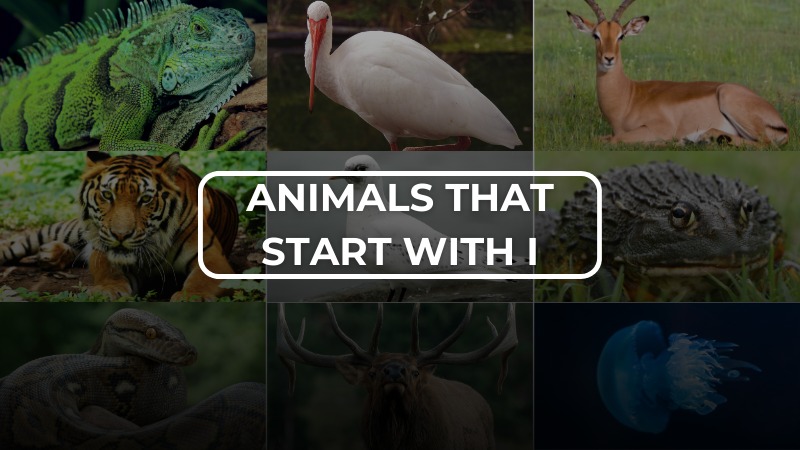Most Popular Animals Start With I?
The animal kingdom is a treasure trove of diversity, and exploring its unique members is always fascinating. This time, we’re turning the spotlight on animals whose names begin with the letter ‘I.’ From the graceful Indian star tortoise to the intriguing Indian cobra, these creatures showcase nature’s remarkable variety. Whether you’re a secondary school student eager to learn, discover fun facts, or simply curious about the wonders of the natural world, this list of animals starting with ‘I’ is sure to captivate and expand your knowledge!
1. Irish Wolfhound
The Irish Wolfhound (Canis lupus familiaris) is one of the tallest dog breeds, originally bred in Ireland for hunting wolves and large game. Now cherished worldwide as a companion animal, it thrives in temperate climates with proper care. Males stand at least 32 inches (81 cm) at the shoulder and weigh 120–180 pounds (54–82 kg), while females are at least 30 inches (76 cm) tall, weighing 105–140 pounds (48–63 kg). This breed has a muscular, long-legged build, a deep chest, and a wiry coat that comes in colors like gray, brindle, red, black, white, and fawn.
Known for its calm and gentle temperament, the Irish Wolfhound is loyal and friendly, making it an excellent family pet. It requires daily walks and room to roam. Litter sizes range from 4 to 8 puppies, with careful attention needed during their rapid growth to prevent joint problems. Though once a fearsome hunter, it is now beloved for its affectionate and graceful nature.
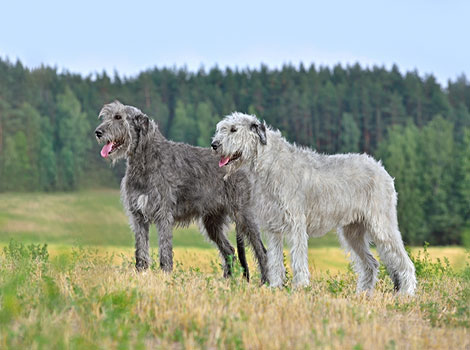
| Attributes | Quick facts |
|---|---|
| Size | 32–35 inches (81–89 cm) at the shoulder |
| Weight | 105–180 lbs (48–82 kg) |
| Lifespan | 6–8 years |
| Habitat | Domesticated; adaptable to various environments |
| Diet | Carnivorous: high-quality dog food and meat |
| Social Structure | Domestic; lives in family groups or with humans |
| Conservation | Not Evaluated |
Fun fact: Often called “gentle giants,” Irish Wolfhounds combine their massive size with a sweet and docile personality, making them a unique and endearing breed!
2. Immortal Jellyfish
The Immortal Jellyfish (Turritopsis dohrnii) is a tiny, translucent marine organism known for its unique ability to reverse aging. Found in warm and temperate oceans worldwide, including the Mediterranean Sea and waters near Japan, it thrives in moderate marine climates. With a bell-shaped body measuring just 0.18–0.4 inches (4.5–10 mm) in diameter, its transparent form shows a slight red or orange hue at the center due to its stomach.
A passive drifter, this jellyfish feeds on plankton, fish eggs, and small invertebrates, capturing prey with tentacles equipped with stinging cells. It reproduces both sexually, releasing eggs and sperm into the water, and asexually, using its remarkable ability to revert to its polyp stage through a process called transdifferentiation. This allows it to restart its life cycle under stress or injury, making it biologically “immortal,” though it can still die from predators or disease.
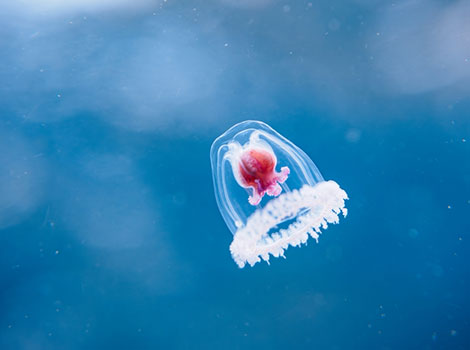
| Attributes | Quick facts |
|---|---|
| Size | 0.18–0.4 inches (4–10 mm) in diameter |
| Weight | Negligible (tiny and lightweight) |
| Lifespan | Potentially indefinite |
| Habitat | Warm waters and oceans, Mediterranean and Japan |
| Diet | Plankton, small fish eggs, and tiny marine organisms |
| Social Structure | Solitary |
| Conservation | Not Evaluated |
Fun fact: The Immortal Jellyfish’s ability to reverse aging has inspired research into aging and regenerative medicine, offering fascinating insights into cellular transformation and longevity!
3. Indo-Chinese Forest Lizard
The Indo-Chinese Forest Lizard (Calotes mystaceus) is a medium-sized arboreal lizard native to Southeast Asia, including Thailand, Myanmar, Laos, Cambodia, and Vietnam. It thrives in warm, humid climates and inhabits tropical forests, secondary growth areas, and plantations. Measuring 10–14 inches (25–35 cm) in length and weighing 2–5 ounces (56–140 grams), it has a slender body with a long tail, sharp claws for climbing, and a spiny crest along its back.
Typically brown or grayish with light markings, this lizard can change color slightly based on mood or surroundings. Males display bright blue throats or heads during the breeding season, adding to their striking appearance. Diurnal and territorial, the lizard actively hunts insects like ants, beetles, and flies among tree foliage, using head bobbing and body displays for communication and courtship. During the warm season, females lay 4–10 eggs in soil or leaf litter, with hatchlings emerging after 6–8 weeks. The young are fully independent from birth.
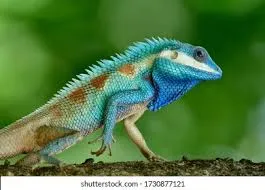
| Attributes | Quick facts |
|---|---|
| Size | 10–12 inches (25–30 cm) including tail |
| Weight | 1–2 oz (30–60 grams) |
| Lifespan | Estimated 5–10 years |
| Habitat | Forests and wooded areas in Southeast Asia |
| Diet | Insects, small invertebrates, and plants |
| Social Structure | Solitary |
| Conservation | Not Evaluated |
Fun fact: The male’s vibrant blue coloration during the breeding season makes the Indo-Chinese Forest Lizard a favorite subject for photographers and reptile enthusiasts!
4. Irukandji Jellyfish
The Irukandji Jellyfish (Carukia barnesi), one of the smallest but most dangerous jellyfish, is native to the warm tropical waters of northern Australia, including the Great Barrier Reef, and other Indo-Pacific regions. With a bell diameter of just 0.4–0.8 inches (1–2 cm) and tentacles up to 3.3 feet (1 meter) long, it is nearly transparent and cube-shaped, making it hard to spot in the water. Equipped with venomous nematocysts on its tentacles, it delivers a potent sting.
A passive drifter, the Irukandji Jellyfish relies on ocean currents for movement but can pulse its bell to adjust its position. Predatory in nature, it captures zooplankton, small fish, and other marine organisms with its stinging tentacles. It reproduces through a complex lifecycle, alternating between a sexual medusa stage and an asexual polyp stage, with no parental care involved.
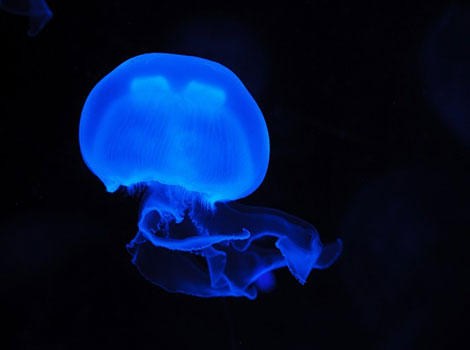
| Attributes | Quick facts |
|---|---|
| Size | 0.2–1 inch (5–25 mm) in bell diameter |
| Weight | Negligible (tiny and lightweight) |
| Lifespan | Estimated weeks to months |
| Habitat | Coastal waters of northern Australia and the Indo-Pacific region |
| Diet | Small fish and plankton |
| Social Structure | Solitary |
| Conservation | Not Evaluated |
Fun fact: Despite its tiny size, the Irukandji Jellyfish can cause “Irukandji Syndrome,” a life-threatening condition with severe pain and cardiovascular complications, making it a formidable creature of the sea!
5. Indian Cobra
The Indian Cobra (Naja naja), also known as the Spectacled Cobra, is a medium to large venomous snake native to the Indian subcontinent, including India, Pakistan, Sri Lanka, Nepal, and Bangladesh. It thrives in tropical and subtropical climates and can be found in diverse habitats such as forests, grasslands, wetlands, and agricultural fields. Typically measuring 5–6.5 feet (1.5–2 meters) in length and weighing 2.2–4.4 pounds (1–2 kg), its color varies from light brown to black, often displaying a “spectacle” pattern on its hood.
Carnivorous in nature, the Indian Cobra preys on small mammals, frogs, birds, and other snakes, using its keen sense of smell and heat sensitivity to locate prey. Primarily nocturnal, it avoids confrontation but will spread its hood as a warning display when threatened. This snake is a skilled climber and swimmer. During the summer, females lay 12–20 eggs in burrows or under debris, with the hatchlings fully independent and venomous from birth.
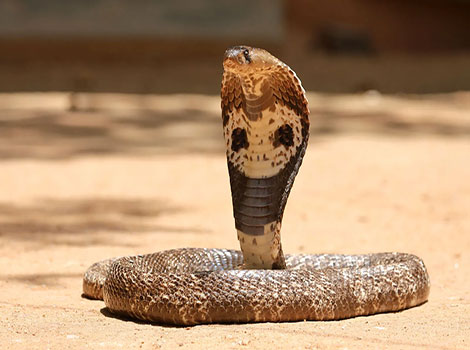
| Attributes | Quick facts |
|---|---|
| Size | 5–7 feet (1.5–2.1 meters) |
| Weight | 2.2–5 lbs (1–2.3 kg) |
| Lifespan | Estimated 20 years |
| Habitat | Forests, plains, agricultural fields, and urban areas across India and Southeast Asia |
| Diet | Rodents, frogs, birds, and small reptiles |
| Social Structure | Solitary |
| Conservation | Least Concern |
Fun fact: Associated with snake charmers, the Indian Cobra reacts to the movement of the charmer’s instrument, not the music, as it cannot “hear” sounds in the way humans do!
6. Indian Spotted Chevrotain
The Indian Spotted Chevrotain (Moschiola indica), also known as the Indian Mouse Deer, is one of the smallest hoofed mammals in the world. Found in southern and central India and parts of Sri Lanka, it inhabits dense forests, shrublands, and thickets near water sources. Thriving in tropical and subtropical climates, this tiny creature measures 21–23 inches (55–60 cm) in length, stands 9–11 inches (23–28 cm) tall at the shoulder, and weighs 4.4–6.6 pounds (2–3 kg). Its brownish coat is adorned with white or yellowish spots and stripes, and males have elongated canine teeth resembling small tusks instead of antlers.
Nocturnal and secretive, the Indian Spotted Chevrotain forages at night for fruits, leaves, shoots, and fallen flowers, staying close to dense vegetation for safety. Polygynous by nature, it breeds year-round, with females giving birth to a single fawn after a 140–155 day gestation. The fawn remains hidden for several weeks, with the mother returning to nurse.
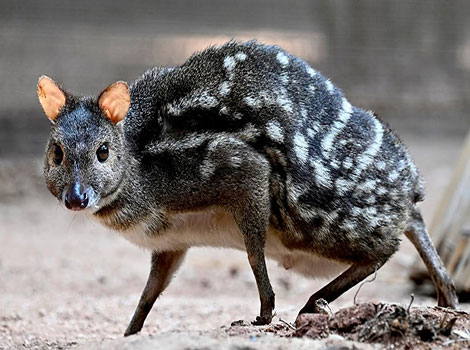
| Attributes | Quick facts |
|---|---|
| Size | 18–22 inches (45–55 cm) |
| Weight | 3–8 lbs (1.5–4 kg) |
| Lifespan | Estimated 10–12 years |
| Habitat | Tropical forests and dense vegetation in India and Sri Lanka |
| Diet | Fruits, leaves, and small invertebrates |
| Social Structure | Solitary or pairs |
| Conservation | Least Concern |
Fun fact: Often called a “mouse deer,” this delicate and shy animal combines a deer’s appearance with rodent-like behavior, making it uniquely fascinating!
7. Indian Civet
The Indian Civet (Viverricula indica) is a medium-sized carnivorous mammal found across South and Southeast Asia, including India, Sri Lanka, Nepal, Bangladesh, China, and nearby countries. It thrives in tropical and subtropical climates and inhabits forests, grasslands, agricultural areas, and even regions near human settlements. Measuring 20–24 inches (50–60 cm) in body length with a 14–16 inch (35–40 cm) tail, it weighs between 4.4–11 pounds (2–5 kg). Its grayish to brownish fur features black stripes and spotted sides, while its tail is ringed with black and white bands.
Omnivorous and nocturnal, the Indian Civet feeds on small mammals, birds, reptiles, insects, fruits, and plants, opportunistically foraging at night. Solitary by nature, it marks its territory using anal scent glands and spends the day resting in dense vegetation or burrows. Breeding year-round, females give birth to 2–5 young after a gestation of 60–70 days, raising them in burrows until independence.
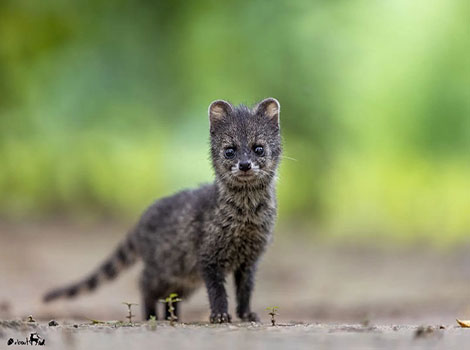
| Attributes | Quick facts |
|---|---|
| Size | 20–30 inches (50–76 cm) excluding tail |
| Weight | 3–10 lbs (1.5–4.5 kg) |
| Lifespan | Estimated 5–10 years |
| Habitat | Forests, grasslands, and urban areas in South and Southeast Asia |
| Diet | Fruits, insects, small mammals, and birds |
| Social Structure | Solitary |
| Conservation | Least Concern |
Fun fact: Historically, Indian Civets were used in the perfume industry for their musk-like secretions, known as “civet musk,” which is now largely replaced by synthetic alternatives!
8. Iguana
The Iguana (Iguana iguana), commonly called the Green Iguana, is a large, arboreal lizard native to the rainforests, mangroves, and lowland forests of Central and South America and the Caribbean. It thrives in warm, humid tropical climates and has been introduced to regions like Florida, Hawaii, and Puerto Rico. Measuring 5–7 feet (1.5–2 meters) in length, including its tail, and weighing 8–20 pounds (3.5–9 kilograms), this robust lizard is typically bright green to grayish-green, though its color may vary with age, habitat, and mood.
Green Iguanas have a crest of spines along their back and tail and a large dewlap under their chin for communication and thermoregulation. Herbivorous, they graze on leaves, flowers, and fruits, spending much of their diurnal life basking in the sun or climbing trees. Excellent swimmers, they can dive into water to evade predators. Females lay 20–70 eggs in burrows after a 2–3 month gestation, with hatchlings emerging independent after 65–90 days.
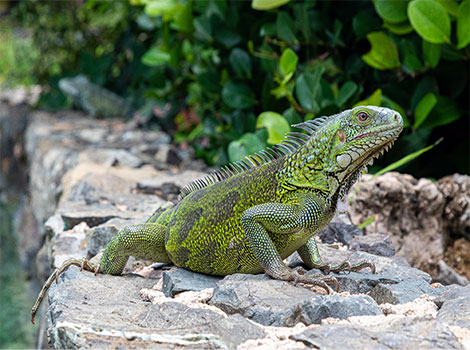
| Attributes | Quick facts |
|---|---|
| Size | 4–6 feet (120–180 cm) |
| Weight | 8–17 lbs (4–8 kg) |
| Lifespan | 10–20 years |
| Habitat | Tropical rainforests, dry forests, and coastal in Central and South America |
| Diet | Leave, fruit, flower, and vegetable |
| Social Structure | Solitary or small groups |
| Conservation | Least Concern |
Fun fact: Iguanas can perform autotomy, detaching their tails to escape predators, with the tail regenerating over time!
9. Indian Bullfrog
The Indian Bullfrog (Hoplobatrachus tigerinus) is a large amphibian found across South and Southeast Asia, thriving in tropical and subtropical climates. It inhabits freshwater ecosystems like ponds, marshes, rivers, and agricultural fields. Measuring 6–8 inches (15–20 cm) in length and weighing 0.5–1 pound (0.2–0.45 kg), this robust frog is greenish-yellow with dark spots. During the breeding season, males develop a bright yellow color and inflate blue vocal sacs to attract mates.
Primarily nocturnal, the Indian Bullfrog hunts insects, small rodents, reptiles, and other amphibians as an ambush predator. It becomes especially active during the monsoon season, when males use loud croaking calls to attract females. Females lay thousands of eggs in water, which hatch into tadpoles within 48–72 hours. Tadpoles grow independently, feeding on algae until they metamorphose into frogs.
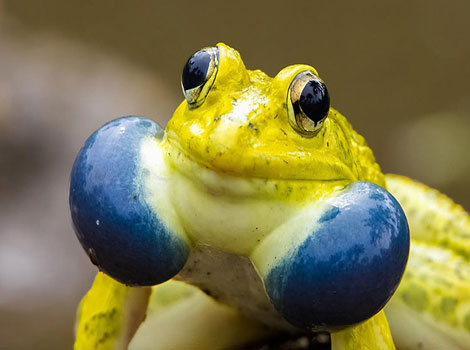
| Attributes | Quick facts |
|---|---|
| Size | 6–7 inches (15–18 cm) |
| Weight | 0.5–1.5 lbs (250–750 grams) |
| Lifespan | Estimated 7–10 years |
| Habitat | Wetlands, ponds, and rice fields in South and Southeast Asia |
| Diet | Insects, small vertebrates, and other frogs |
| Social Structure | Solitary except during breeding |
| Conservation | Least Concern |
Fun fact: The Indian Bullfrog is an invasive species in some areas, like the Andaman Islands, where its voracious appetite poses a significant threat to native wildlife and ecosystems!
10. Impala
The Impala (Aepyceros melampus) is a medium-sized antelope found across eastern and southern Africa, including Kenya, Tanzania, Botswana, Zimbabwe, and South Africa. Preferring warm, tropical to subtropical climates, it inhabits open woodlands, savannas, and grasslands near water sources. Standing 28–36 inches (70–92 cm) tall at the shoulder and measuring 4.5–5.6 feet (120–160 cm) in length, males weigh 88–132 pounds (40–60 kg), while females weigh 66–110 pounds (30–50 kg). Its reddish-brown coat with lighter flanks, white belly, and black markings on the tail and hindquarters form a distinctive “M” pattern.
Impalas are flexible feeders, grazing on grasses and browsing on shrubs, fruits, and herbs depending on seasonal vegetation. Diurnal and agile, they live in mixed-sex herds, bachelor groups, or as territorial males. They can leap over 10 feet (3 meters) high and 33 feet (10 meters) in a single bound to escape predators. Breeding occurs during the rainy season, with females giving birth to a single calf after a 6–7 month gestation. Calves remain hidden for a few weeks before joining the herd.
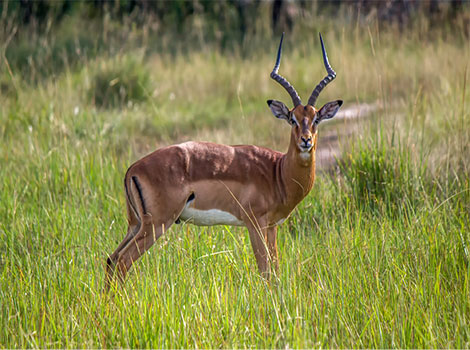
| Attributes | Quick facts |
|---|---|
| Size | 28–36 inches (70–92 cm) at shoulder height |
| Weight | 88–165 lbs (40–75 kg) |
| Lifespan | 12–15 years |
| Habitat | Savannas, woodlands, and grasslands in Africa |
| Diet | Grasses, leaves, and shoots |
| Social Structure | Herds (mixed or bachelor groups) |
| Conservation | Least Concern |
Fun fact: Impalas have scent glands on their ankles that release a unique smell when they jump, helping the herd regroup during predator attacks!
11. Iberian Mole
The Iberian Mole (Talpa occidentalis) is a small, subterranean mammal native to the Iberian Peninsula, particularly Spain and Portugal. It inhabits forests, grasslands, agricultural fields, and gardens with loose, moist soil, thriving in temperate climates with high soil humidity. Measuring 4.5–6 inches (11–15 cm) in body length, with a tail of 0.8–1.2 inches (2–3 cm), and weighing 1.5–3.5 ounces (40–100 grams), its compact body is covered in dense, velvety dark gray or black fur. Adapted for digging, it has large, paddle-like forelimbs with sharp claws, poor eyesight, and an acute sense of touch and smell.
Iberian Moles are insectivorous, tunneling through soil to hunt earthworms, insects, and larvae, using vibrations to locate prey. Solitary by nature, they are active day and night, alternating between digging, foraging, and resting. During spring, males expand their territories to find mates, and females give birth to 3–5 young in a grass-lined burrow nest. The young are weaned after 4–5 weeks.
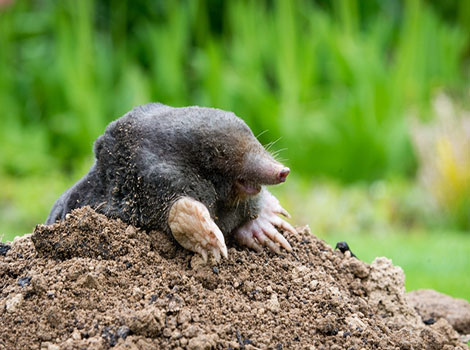
| Attributes | Quick facts |
|---|---|
| Size | 4–5 inches (10–13 cm) |
| Weight | 1–2.5 oz (30–70 grams) |
| Lifespan | Estimated 2–3 years |
| Habitat | Forests, grasslands, and agricultural areas in the Iberian Peninsula |
| Diet | Earthworms, insects, and small invertebrates |
| Social Structure | Solitary |
| Conservation | Least Concern |
Fun fact: Iberian Moles are exceptional diggers, capable of creating tunnels at an impressive speed of up to 15 feet (4.5 meters) per hour!
12. Indian Jackal
The Indian Jackal (Canis aureus indicus), a subspecies of the Golden Jackal, is a medium-sized carnivore found across the Indian subcontinent, including India, Nepal, Bhutan, Pakistan, and Bangladesh. It thrives in diverse habitats such as forests, grasslands, wetlands, scrublands, and areas near human settlements, adapting well to tropical, subtropical, and arid climates. Measuring 28–33 inches (71–84 cm) in length, with an additional 8–10 inches (20–25 cm) of bushy tail, and weighing 15–35 pounds (7–16 kg), it has a slender build with a grizzled coat ranging from pale gold to reddish-brown.
An omnivorous and opportunistic feeder, the Indian Jackal consumes small mammals, birds, reptiles, insects, carrion, fruits, and vegetation. Active primarily at dawn and dusk, it lives in monogamous pairs or small family groups, communicating with vocalizations like howls and barks to mark territory. Breeding once a year, females give birth to 2–6 pups after a 60–63 day gestation, with both parents caring for the young.
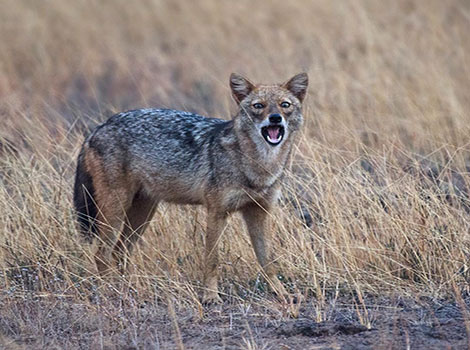
| Attributes | Quick facts |
|---|---|
| Size | 28–33 inches (70–85 cm) excluding tail |
| Weight | 15–30 lbs (7–14 kg) |
| Lifespan | 10–12 years |
| Habitat | Grasslands, forests, and semi-arid regions across India |
| Diet | Omnivorous: small mammals, birds, fruits, and carrion |
| Social Structure | Pairs or small family groups |
| Conservation | Least Concern |
Fun fact: Known for its intelligence, the Indian Jackal is a prominent figure in Indian folklore, often depicted as a cunning and clever character in traditional tales!
13. Ivory Gull
The Ivory Gull (Pagophila eburnea) is a medium-sized bird found throughout the Arctic Circle, including northern Canada, Greenland, Russia, and the Svalbard Archipelago. Adapted to frigid polar climates, it inhabits Arctic coasts, sea ice, and icebergs year-round, with slight southward migration in winter following the edge of pack ice. Measuring 16–18 inches (40–46 cm) in length with a wingspan of 36–41 inches (91–104 cm) and weighing 1.1–1.9 pounds (0.5–0.85 kg), it is known for its entirely white plumage, black legs, and a black-tipped yellow bill, providing effective camouflage in icy environments.
Ivory Gulls are scavengers, feeding on seal remains, fish, and carrion, often following polar bears to scavenge leftovers. They also hunt small fish and invertebrates. Social and diurnal, these birds form small flocks and nest in remote rocky Arctic areas during summer, where females lay 1–3 eggs. Both parents incubate the eggs for 24–26 days and care for the chicks until fledging at 5–6 weeks.
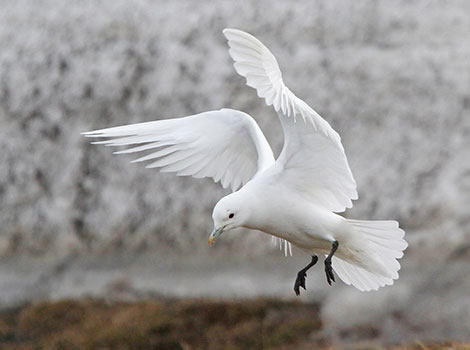
| Attributes | Quick facts |
|---|---|
| Size | 16–18 inches (40–46 cm) |
| Weight | 1–1.5 lbs (450–700 grams) |
| Lifespan | Estimated 10–20 years |
| Habitat | Arctic coasts, pack ice, and open sea |
| Diet | Fish, crustaceans, and scavenged carrion |
| Social Structure | Colonial during breeding, solitary or small groups otherwise |
| Conservation | Near Threatened |
Fun fact: Ivory Gulls have exceptional cold tolerance, thriving in sub-zero Arctic conditions thanks to specialized adaptations!
14. Indian Star Tortoise
The Indian Star Tortoise (Geochelone elegans) is a small-to-medium-sized tortoise native to India, Sri Lanka, and parts of Pakistan. It inhabits dry scrub forests, grasslands, and semi-arid regions, thriving in hot, dry climates but adapting to seasonal monsoons. Males typically measure 5–7 inches (13–18 cm) and weigh 1–2 pounds (0.5–1 kg), while females are larger, reaching 7–12 inches (18–30 cm) and weighing 2–6 pounds (1–3 kg). Its dark brown or black dome-shaped shell features striking yellow or cream-colored star patterns, providing effective camouflage in its natural environment.
Herbivorous, this tortoise grazes on grasses, fruits, flowers, and succulent plants, usually during cooler parts of the day. Shy and crepuscular, it avoids extreme heat by resting in shaded areas and retreats into its shell when threatened. During the monsoon season, females lay 2–10 eggs in soil nests, which incubate for 90–170 days. Hatchlings are independent from birth.
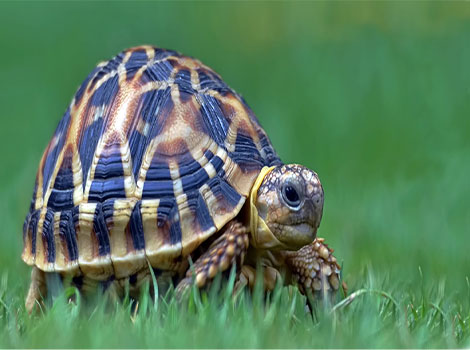
| Attributes | Quick facts |
|---|---|
| Size | 7–15 inches (18–38 cm) |
| Weight | 1–6 lbs (0.5–2.7 kg) |
| Lifespan | 35–80 years |
| Habitat | Dry areas, scrub forests, and grasslands in India, Sri Lanka, and Pakistan |
| Diet | Grasses, leaves, flowers, and fruits |
| Social Structure | Solitary |
| Conservation | Vulnerable |
Fun fact: The Indian Star Tortoise’s beautiful star-patterned shell not only camouflages it but also helps break up its outline, reducing the risk of predation in the wild!
15. Indian Bison
The Indian Bison, or Gaur (Bos gaurus), is the largest species of wild cattle, found in tropical and subtropical forests and grasslands across India, Nepal, Bhutan, Bangladesh, and Southeast Asia. Standing 5.6–7.2 feet (170–220 cm) tall at the shoulder and measuring 8–10 feet (250–300 cm) in length, males weigh 2,200–3,300 pounds (1,000–1,500 kg), while females weigh 1,500–2,200 pounds (700–1,000 kg). It has a dark brown to black coat, a lighter-colored muzzle, and distinctive white “stockings” on its legs, along with large, curved horns up to 45 inches (115 cm) long.
These herbivorous giants graze on grasses and browse on leaves, fruits, and tree bark, foraging during early morning and late afternoon. Social animals, they live in herds of 10–40 led by a dominant female, while adult males are often solitary or form bachelor groups. Breeding occurs year-round, with females giving birth to a single calf after a 9-month gestation. Herds protect calves collectively, defending against predators.
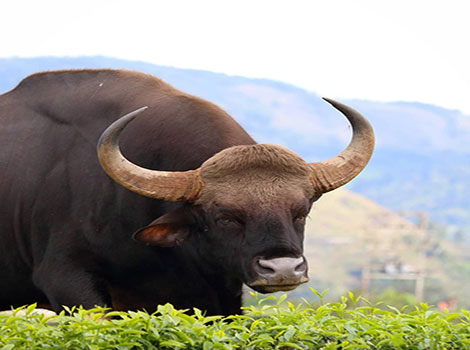
| Attributes | Quick facts |
|---|---|
| Size | 8–10 feet (250–300 cm) in length |
| Weight | 1,000–2,200 lbs (450–1,000 kg) |
| Lifespan | 20–25 years |
| Habitat | Forests, grasslands, and hilly terrains in South and Southeast Asia |
| Diet | Grasses, leaves, fruits, and shrubs |
| Social Structure | Herds of 8–11 individuals |
| Conservation | Vulnerable |
Fun fact: The Gaur’s massive size and strength allow it to intimidate even apex predators like tigers, making it a formidable presence in its habitat!
16. Indian Pangolin
The Indian Pangolin (Manis crassicaudata) is a medium-sized, scaly mammal native to the Indian subcontinent, including India, Sri Lanka, Pakistan, Nepal, and Bangladesh. Found in forests, grasslands, and scrublands, it thrives in tropical and subtropical climates. Measuring 33–47 inches (84–120 cm) long, including its tail, and weighing 22–30 pounds (10–15 kg), this solitary creature is covered in protective yellowish-brown to dark brown keratin scales. Its long, conical head, prehensile tail, powerful forelimbs, and long, sticky tongue are perfectly adapted for digging and feeding.
Nocturnal by nature, the Indian Pangolin spends its days resting in burrows and emerges at night to forage for ants and termites, which it digs out with its strong claws. It is shy and curls into a ball when threatened. Females give birth to a single pup after a 65–70 day gestation, protecting the young until its scales harden.
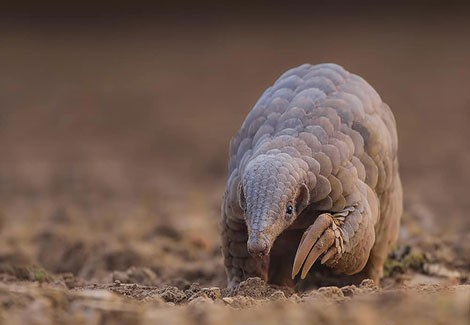
| Attributes | Quick facts |
|---|---|
| Size | 18–25 inches (46–63 cm) excluding tail |
| Weight | 22–35 lbs (10–16 kg) |
| Lifespan | Estimated 12–15 years |
| Habitat | Grasslands, dry forests, and scrublands in South Asia |
| Diet | Ants and termites |
| Social Structure | Solitary |
| Conservation | Endangered |
Fun fact: The Indian Pangolin’s tongue can extend longer than its body, allowing it to reach deep into termite mounds for its favorite food!
17. Iriomote Cat
The Iriomote Cat (Prionailurus bengalensis iriomotensis), a subspecies of the Leopard Cat, is a small wild feline endemic to Japan’s Iriomote Island in Okinawa Prefecture. This elusive cat inhabits dense subtropical forests, mangroves, and river valleys in the island’s warm, humid climate. Measuring 20–24 inches (50–60 cm) in body length with a 9–11 inch (23–28 cm) tail, it stands about 10–12 inches (25–30 cm) at the shoulder and weighs 6.6–10 pounds (3–4.5 kg). Its dark brown to grayish coat, faint black spots, and stripes provide excellent camouflage.
A nocturnal carnivore, the Iriomote Cat preys on small mammals, birds, lizards, amphibians, insects, and crustaceans. It hunts stealthily on the ground but is also a skilled climber and swimmer. Solitary and territorial, it marks its range with scent and spends its days resting in dense vegetation. During the breeding season (February–March), females give birth to 1–2 kittens after a 60-day gestation, raising them alone until they become independent after 9–12 months.
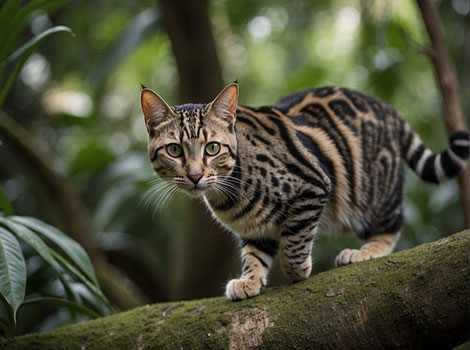
| Attributes | Quick facts |
|---|---|
| Size | 18–24 inches (45–60 cm) excluding tail |
| Weight | 7–10 lbs (3–4.5 kg) |
| Lifespan | Estimated 8–10 years in the wild |
| Habitat | Dense forests and coastal areas on Iriomote Island, Japan |
| Diet | Small mammals, birds, reptiles, and amphibians |
| Social Structure | Solitary |
| Conservation | Endangered |
Fun fact: With fewer than 250 individuals remaining, the Iriomote Cat is one of the rarest wild cats on Earth and is critically endangered.
As we explore the captivating world of animals starting with ‘I,’ it’s clear that each group offers something unique and intriguing. Now, let’s narrow our focus to mammals, uncovering the fascinating species that stand out within this remarkable class.
Mammals that start with I
Mammals are some of the most fascinating creatures on Earth, and those whose names start with the letter “I” are no exception. From the elusive Indian pangolin to the impressive Indian elephant, these mammals showcase unique traits and vital roles within their ecosystems. Let’s take a closer look at these incredible mammals, exploring their distinctive characteristics and the habitats they call home.
18. Indian Giant Squirrel
The Indian Giant Squirrel (Ratufa indica), also known as the Malabar Giant Squirrel, is one of the largest tree squirrels in the world. Native to peninsular India, it thrives in tropical and subtropical forests, including the Western Ghats, central India, and parts of the Eastern Ghats. Measuring 10–18 inches (25–45 cm) in body length with a 20–24 inch (50–60 cm) bushy tail, this arboreal squirrel weighs 4.4–6.6 pounds (2–3 kilograms). Its multicolored fur, with shades of black, brown, cream, and rust, provides excellent camouflage in the dappled forest light.
Diurnal and arboreal, the Indian Giant Squirrel spends most of its time in tree canopies, rarely descending to the ground. It is omnivorous, feeding on fruits, nuts, seeds, flowers, bark, and occasionally insects or bird eggs. Solitary and territorial, it uses loud calls to communicate and deter intruders, leaping between branches with the help of its strong legs and tail. Females build spherical nests in treetops and give birth to 1–3 young after a gestation of 28–35 days, caring for the offspring until independence.
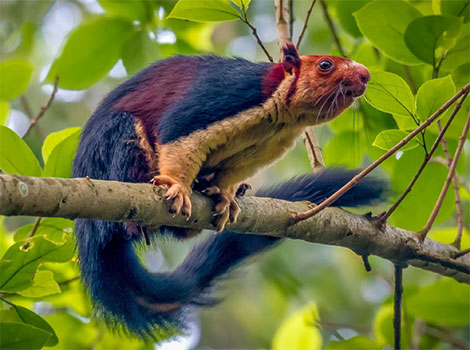
| Attributes | Quick facts |
|---|---|
| Size | 10–18 inches (25–46 cm) excluding tail, with a tail of equal length |
| Weight | 3–4 lbs (1.5–2 kg) |
| Lifespan | Estimated 20 years |
| Habitat | Tropical forests in India |
| Diet | Fruits, nuts, seeds, flowers, and bark |
| Social Structure | Solitary or pairs |
| Conservation | Least Concern |
Fun fact: The Indian Giant Squirrel’s vibrant fur doubles as camouflage, helping it blend seamlessly into its forest canopy habitat!
19. Indian Palm Squirrel
The Indian Palm Squirrel (Funambulus palmarum), also known as the Three-Striped Palm Squirrel, is a small and agile rodent native to India and Sri Lanka, but it has been introduced to regions like Australia and Southeast Asia. Measuring 6–7.9 inches (15–20 cm) in body length with a 5.5–6.7 inch (14–17 cm) bushy tail, it weighs 3–5 ounces (85–140 grams). Its brownish-gray coat is marked by three white or cream stripes running from head to tail, making it easily recognizable.
These diurnal and highly active squirrels are omnivorous, feeding on fruits, nuts, seeds, flowers, and insects. They are often seen darting across trees or buildings, storing food for later. Breeding occurs twice a year, in spring and autumn, with females giving birth to 2–4 young after a 34–40 day gestation. The mother raises the blind and hairless offspring in a nest of leaves and twigs until they are independent at about 10 weeks.
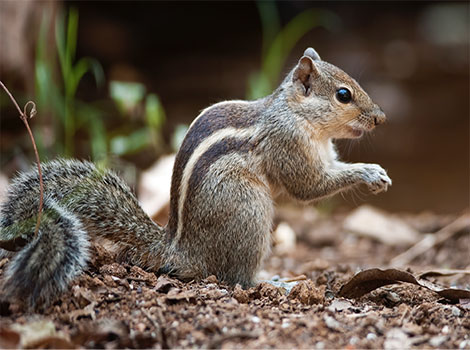
| Attributes | Quick facts |
|---|---|
| Size | 6–7.8 inches (15–20 cm) including tail |
| Weight | 2–4 oz (50–100 grams) |
| Lifespan | 2–4 years in the wild, up to 5 years in captivity |
| Habitat | Urban areas, forests, and gardens in South Asia |
| Diet | Fruits, nuts, seeds, and insects |
| Social Structure | Solitary or small groups |
| Conservation | Least Concern |
Fun fact: According to Indian mythology, the Indian Palm Squirrel earned its stripes as a blessing from Lord Rama for helping build a bridge to Lanka!
20. Indian Flying Fox
The Indian Flying Fox (Pteropus medius), also known as the Greater Indian Fruit Bat, is one of the largest bat species in the world. Found throughout the Indian subcontinent, including India, Pakistan, Nepal, Sri Lanka, and Bangladesh, it inhabits forests, wetlands, and urban areas with fruiting trees. With a wingspan of up to 4.9 feet (1.5 meters), a length of 9.1–11.4 inches (23–29 cm), and weighing 2.4–3.3 pounds (1.1–1.5 kilograms), this bat has reddish-brown fur, a lighter underbelly, and a fox-like face.
A nocturnal frugivore, the Indian Flying Fox feeds on ripe fruits like mangoes, bananas, figs, and guavas, as well as nectar and flowers. It relies on sharp eyesight and a keen sense of smell to locate food, traveling up to 30 miles (50 kilometers) in a single night. Social by nature, these bats roost in large colonies near water during the day and become active at dusk. Females give birth to a single pup after a 5.5-month gestation, carrying it while foraging for the first few weeks.
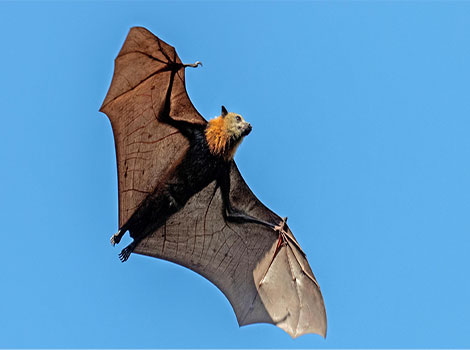
| Attributes | Quick facts |
|---|---|
| Size | Wingspan of 4–5 feet (1.2–1.5 m) |
| Weight | 2–3.5 lbs (0.9–1.6 kg) |
| Lifespan | 15–30 years |
| Habitat | Forests, wetlands, and urban areas in South Asia |
| Diet | Fruits, nectar, and flowers |
| Social Structure | Large colonies |
| Conservation | Least Concern |
Fun fact: Indian Flying Foxes are crucial for pollination and seed dispersal, playing a key role in maintaining tropical forest ecosystems and supporting agricultural productivity!
21. Island Fox
The Island Fox (Urocyon littoralis) is a small, endemic fox species found on the Channel Islands off southern California, USA. Measuring 18–20 inches (46–52 cm) in length (excluding its 4–6 inch tail) and standing about 12 inches (30 cm) tall, it weighs just 2–6 pounds (0.9–2.7 kg), making it one of the smallest foxes. Its grayish coat, reddish sides, white underside, and black-tipped tail help it blend into its grassland, coastal scrub, forest, and dune habitats. Each island population is a unique subspecies, adapted to its specific environment.
Island Foxes are diurnal, omnivorous feeders, consuming insects, fruits, berries, small mammals, birds, and carrion. They are monogamous, mating in late winter, with females giving birth to 1–5 kits after a 50–63 day gestation. Both parents care for the kits, which become independent at 6–7 months. Highly territorial, they communicate with vocalizations, scent marking, and body language.
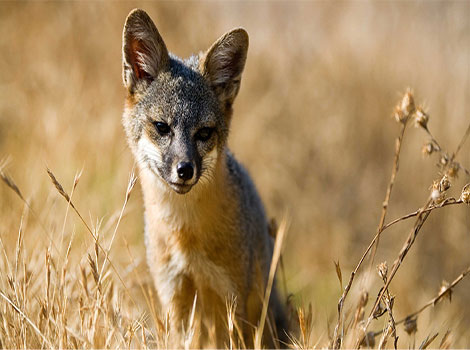
| Attributes | Quick facts |
|---|---|
| Size | 18–20 inches (45–50 cm) |
| Weight | 4–6 lbs (1.8–2.7 kg) |
| Lifespan | 4–15 years |
| Habitat | Chaparral, grasslands, and forests on the Channel Islands, California |
| Diet | Fruits, insects, small mammals, and birds |
| Social Structure | Monogamous pairs or solitary |
| Conservation | Near Threatened |
Fun fact: The Island Fox is considered a keystone species in the Channel Islands ecosystem, playing a crucial role in maintaining the balance of predator-prey relationships.
22. Indian Leopard
The Indian Leopard (Panthera pardus fusca) is a medium-sized subspecies of leopard found across India, Nepal, Bhutan, Pakistan, and Sri Lanka. Adaptable to various habitats, it thrives in forests, grasslands, scrublands, and mountainous regions, enduring climates from arid zones to tropical rainforests and cold mountains. Males measure 4.9–6.2 feet (1.5–1.9 meters) in length, including the tail, and weigh 110–170 pounds (50–77 kg), while females are slightly smaller, at 4.6–5.3 feet (1.4–1.6 meters) and 64–110 pounds (29–50 kg). Its golden-yellow coat with black rosettes and lighter underside provides effective camouflage.
A solitary and stealthy carnivore, the Indian Leopard preys on deer, monkeys, wild boar, birds, and small mammals, occasionally targeting livestock. It hunts by ambushing prey and often drags its catch into trees to avoid scavengers. Nocturnal and territorial, it marks its range with scent and claw marks. Females give birth to 1–3 cubs after a 90–105 day gestation, raising them alone and teaching survival skills until independence at 18–24 months.
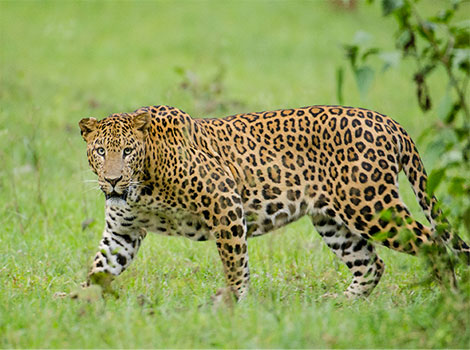
| Attributes | Quick facts |
|---|---|
| Size | 4.25–6.25 feet (1.3–1.9 m) |
| Weight | 64–154 lbs (29–70 kg) |
| Lifespan | 12–17 years |
| Habitat | Forests, grasslands, and rocky terrains across India |
| Diet | Deer, wild boar, monkeys, and smaller prey |
| Social Structure | Solitary |
| Conservation | Vulnerable |
Fun fact: The Indian Leopard is exceptionally adaptable, thriving even in human-dominated landscapes and occasionally venturing into urban areas, making it one of the most versatile big cats!
23. Indian Rhinoceros
The Indian Rhinoceros (Rhinoceros unicornis), also known as the Greater One-Horned Rhinoceros, is the largest of all Asian rhino species. Native to northern India and Nepal, it inhabits grasslands, wetlands, riverine forests, and floodplains near the Himalayan foothills. Standing 5.7–6.6 feet (1.7–2 meters) tall at the shoulder and measuring 10–12 feet (3–3.8 meters) in length, it weighs 4,000–6,000 pounds (1,800–2,700 kilograms). Its grayish-brown skin folds resemble armor plating, and its single horn, made of keratin, grows up to 8–20 inches (20–50 cm).
Herbivorous, the Indian Rhinoceros feeds on grasses, aquatic plants, fruits, and tree bark, using its prehensile lip to grab food. It grazes during the morning and evening and wallows in water or mud to cool off and repel parasites. Generally solitary, it tolerates others in overlapping territories. Females give birth to a single calf after a 15–16 month gestation, and the young remain with the mother for 2–4 years.
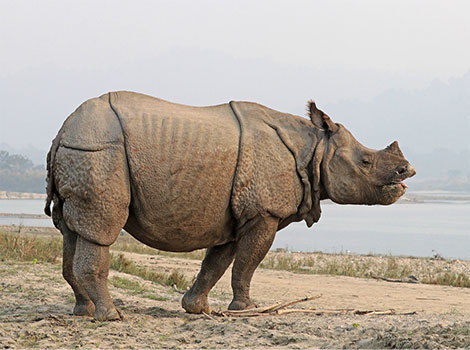
| Attributes | Quick facts |
|---|---|
| Size | 12–13 feet (3.7–4 m) in length |
| Weight | 4,000–6,000 lbs (1,800–2,700 kg) |
| Lifespan | 35–45 years |
| Habitat | Grasslands, swamps, and riverine forests in the Indian subcontinent |
| Diet | Grasses, leaves, fruits, and aquatic plants |
| Social Structure | Solitary except during mating and mother-offspring pairs |
| Conservation | Vulnerable |
Fun fact: The Indian Rhinoceros is an excellent swimmer, often crossing rivers to access new feeding grounds. It is also a conservation success, with populations rebounding due to effective protection measures!
24. Indochinese Tiger
The Indochinese Tiger (Panthera tigris corbetti) is a medium-sized tiger subspecies native to Southeast Asia, inhabiting dense tropical and subtropical forests, grasslands, and montane regions in Thailand, Vietnam, Laos, Cambodia, and Myanmar. Thriving in warm, humid climates, males measure 8–9.5 feet (2.4–2.9 meters) in length and weigh 330–430 pounds (150–195 kilograms), while females are 7.5–8.5 feet (2.3–2.6 meters) long and weigh 220–290 pounds (100–130 kilograms). Its bright orange coat with narrow black stripes and white underbelly helps it blend into dense vegetation for stealthy ambush hunting.
Carnivorous, the Indochinese Tiger preys on medium to large ungulates like deer, wild boar, and banteng, relying on its muscular build and powerful pounce. Nocturnal and solitary, it patrols large territories marked with scent and scratch marks. Females give birth to 2–4 cubs after a 3.5-month gestation, raising them for 18–24 months to teach hunting and survival skills.
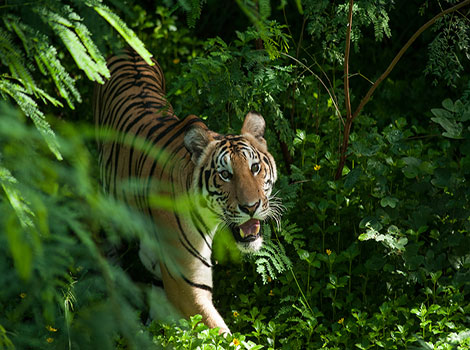
| Attributes | Quick facts |
|---|---|
| Size | 8–10 feet (2.4–3 m) |
| Weight | 220–430 lbs (100–195 kg) |
| Lifespan | 15–20 years |
| Habitat | Forests, grasslands, and wetlands in Southeast Asia |
| Diet | Deer, wild boar, and other large ungulates |
| Social Structure | Solitary |
| Conservation | Endangered |
Fun fact: With fewer than 350 individuals left in the wild, the Indochinese Tiger is critically endangered due to habitat loss and poaching, underscoring the need for urgent conservation efforts.
25. Irish Draught Horse
The Irish Draught Horse (Equus ferus caballus) is a versatile and robust breed originating in Ireland, now cherished worldwide. Standing 15.1–16.3 hands (61–67 inches or 155–170 cm) at the withers and weighing 1,300–1,500 pounds (590–680 kg), this medium to large draft horse has a compact, muscular body with a deep chest, short back, and powerful hindquarters. It comes in various colors, including gray, chestnut, bay, black, and roan, with strong legs and kind eyes that reflect its calm and willing temperament.
Originally bred for farm work and carriage pulling, the Irish Draught Horse is highly adaptable, excelling in equestrian sports like show jumping and hunting. Herbivorous, it thrives on a diet of hay, grass, and grains, requiring balanced nutrition for its active lifestyle. Breeding typically results in a single foal after an 11-month gestation, with the mother nurturing the foal until weaning at 4–6 months.
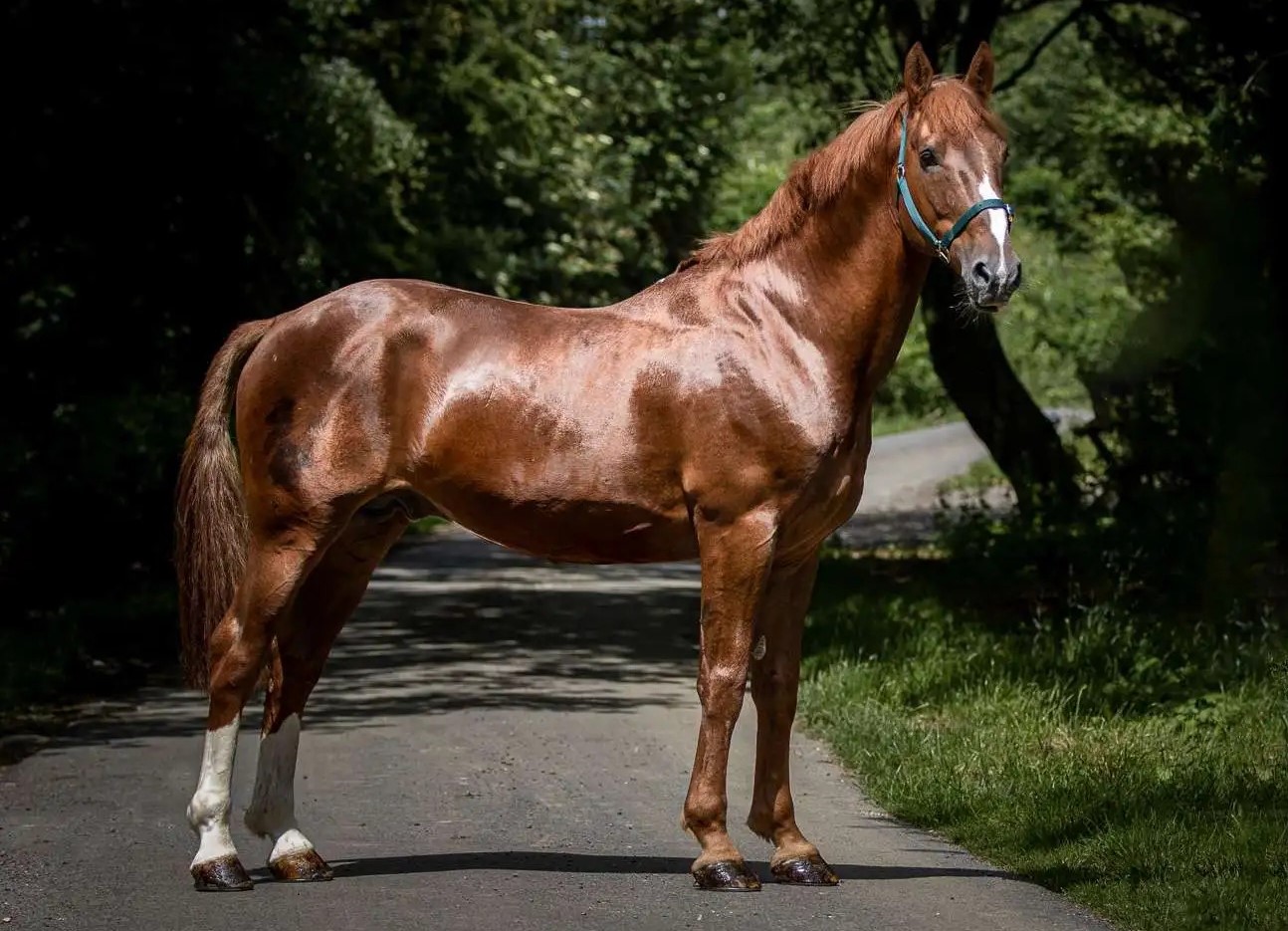
| Attributes | Quick facts |
|---|---|
| Size | 15.2–16.3 hands (62–67 inches or 157–170 cm) at the shoulder |
| Weight | 1,300–1,500 lbs (590–680 kg) |
| Lifespan | 25–30 years |
| Habitat | Domesticated; adaptable to various environments |
| Diet | Hay, grass, grains |
| Social Structure | Domestic; lives in herds or with humans |
| Conservation | Endangered |
Fun fact: Renowned for its strength and stamina, the Irish Draught Horse is often crossed with Thoroughbreds to create the Irish Sport Horse, a favorite in competitive equestrian events worldwide!
26. Indian Elephant
The Indian Elephant (Elephas maximus indicus), a subspecies of the Asian Elephant, is a majestic herbivore found in tropical and subtropical regions of India, Nepal, Bhutan, Bangladesh, Sri Lanka, and parts of Southeast Asia. Slightly smaller than African elephants, it stands 7–10 feet (2–3 meters) tall at the shoulder, measures 18–21 feet (5.5–6.4 meters) long, and weighs 4,000–11,000 pounds (2,000–5,000 kilograms). Its grayish-brown skin often appears dusty from mud baths, and its smaller ears and domed head distinguish it from its African relatives.
Indian Elephants live in matriarchal herds led by an older female, while males are often solitary or form bachelor groups. Consuming up to 330 pounds (150 kilograms) of food and drinking 50 gallons (190 liters) of water daily, they feed on grasses, leaves, fruits, bark, and roots. Females have a gestation period of 18–22 months, giving birth to calves weighing 200–250 pounds (90–115 kilograms). The herd protects and nurtures the young, fostering strong social bonds.
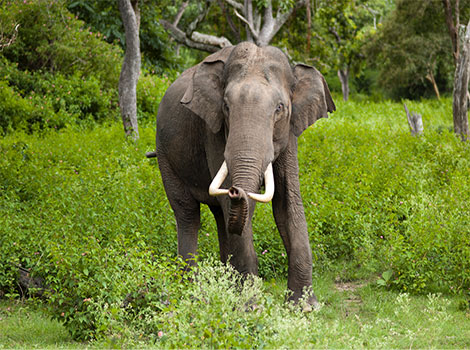
| Attributes | Quick facts |
|---|---|
| Size | 18–21 feet (5.5–6.4 m) in length |
| Weight | 6,000–11,000 lbs (2,700–5,000 kg) |
| Lifespan | 60–70 years |
| Habitat | Forests, grasslands, and wetlands in India and Southeast Asia |
| Diet | Grasses, fruits, bark, and roots |
| Social Structure | Matriarchal herds; males are often solitary |
| Conservation | Endangered |
Fun fact: Indian Elephants are ecosystem engineers, dispersing seeds through their dung and playing a critical role in maintaining forest biodiversity!
27. Indri
The Indri (Indri indri), the largest living lemur, is a striking primate endemic to Madagascar’s eastern rainforests. Preferring humid, densely vegetated habitats, it measures 22–28 inches (55–72 cm) in length, excluding its short tail, and weighs 13–21 pounds (6–9.5 kg). Its black-and-white fur patterns vary among individuals, and it has long limbs and powerful hind legs for leaping up to 30 feet (9 meters) between trees.
A diurnal and social species, the Indri lives in small family groups of a breeding pair and offspring. These groups are territorial, marking their ranges with loud, wailing calls that echo up to 2 kilometers. Herbivorous, the Indri feeds on young leaves, flowers, seeds, and fruits high in the canopy. Reproduction occurs every 2–3 years, with females giving birth to a single infant after a 120–150 day gestation. Infants cling to their mother’s belly before transitioning to her back, receiving care for 6–8 months.
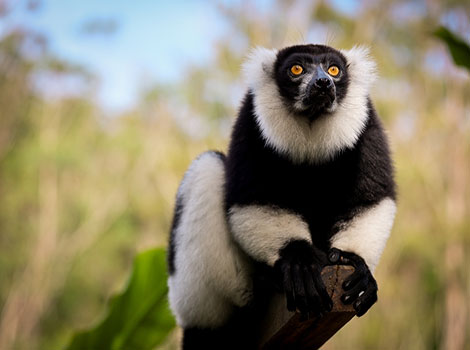
| Attributes | Quick facts |
|---|---|
| Size | 24–28 inches (60–70 cm) excluding tail (which is vestigial) |
| Weight | 13–21 lbs (6–9.5 kg) |
| Lifespan | Estimated 15–20 years |
| Habitat | Tropical rainforests of Madagascar |
| Diet | Leaves, flowers, and fruits |
| Social Structure | Small family groups (monogamous pairs with offspring) |
| Conservation | Critically Endangered |
Fun fact: The Indri’s haunting, human-like vocalizations are among the most iconic sounds of Madagascar’s rainforests, serving both communication and territorial functions!
28. Idaho Ground Squirrel
The Idaho Ground Squirrel (Urocitellus brunneus) is a small, burrowing rodent endemic to southwestern Idaho, USA. Measuring 7.5–9.8 inches (19–25 cm) in length and weighing 5.3–7.4 ounces (150–210 grams), it has brownish-gray fur with a lighter underside and faint stripes or mottled markings on its back. Its rounded body, short limbs, and small bushy tail are well-suited for its burrowing lifestyle in open grasslands, meadows, and sagebrush areas.
These diurnal squirrels are herbivorous, feeding on grasses, seeds, flowers, and occasionally insects. They actively forage during the day, storing food in extensive burrow systems for later use. Idaho Ground Squirrels live in colonies and hibernate from late summer or early fall, re-emerging in spring. Breeding occurs once a year after hibernation, with females giving birth to 4–8 pups following a 22–23 day gestation. The young remain in the burrow for several weeks before venturing outside.
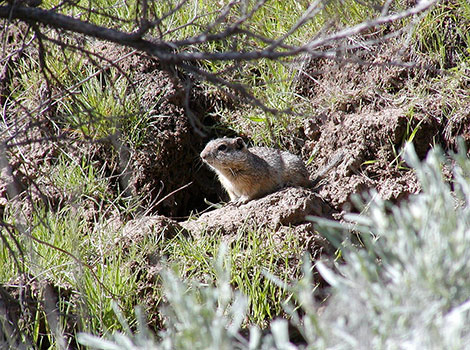
| Attributes | Quick facts |
|---|---|
| Size | 6–9 inches (15–23 cm) |
| Weight | 4–10 oz (115–285 grams) |
| Lifespan | Estimated 1–3 years in the wild |
| Habitat | Meadows, grasslands, and sagebrush regions in Idaho, USA |
| Diet | Grasses, seeds, roots, and insects |
| Social Structure | Colonial burrow systems |
| Conservation | Vulnerable |
Fun fact: The Idaho Ground Squirrel faces conservation challenges, with its two subspecies—the Northern Idaho Ground Squirrel (Urocitellus brunneus brunneus) and Southern Idaho Ground Squirrel (Urocitellus brunneus endemicus)—listed as threatened due to habitat loss and fragmentation.
29. Inia
The Amazon River Dolphin, also called the Pink River Dolphin (Inia geoffrensis), lives in the warm, tropical waters of the Amazon and Orinoco rivers in South America. These dolphins are pretty amazing! Males can grow up to 8.2 feet long and weigh 408 pounds, while females are smaller, around 6.6 feet long and 220 pounds. They have long, flexible necks, a hump instead of a dorsal fin, and a long beak filled with about 140 teeth to grab their food. Younger dolphins are gray, but as males grow older, they turn pink, and their color gets even brighter during play or when trying to impress a mate.
These playful creatures love snacking on fish like piranhas, crustaceans, and sometimes even small turtles. They’re super flexible, which helps them search for food in flooded forests. Usually, they live on their own or in tiny groups, using echolocation to find their way in murky waters. Moms take care of their calves for up to two years, teaching them how to hunt and survive.
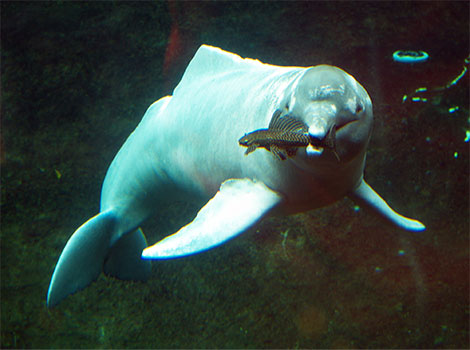
| Attributes | Quick facts |
|---|---|
| Size | 5.5–8.5 feet (1.7–2.6 m) |
| Weight | 150–400 lbs (70–180 kg) |
| Lifespan | 20–30 years |
| Habitat | Freshwater rivers, lakes, and flooded forests in the Amazon and Orinoco basins |
| Diet | Fish, crustaceans, and small aquatic animals |
| Social Structure | Small groups or solitary |
| Conservation | Endangered |
Fun fact: Did you know their famous pink color comes from tiny blood vessels near their skin? And guess what? The pinker a male is, the more likely he’ll attract a female! How cool is that?
30. Irrawaddy Dolphin
The Irrawaddy Dolphin (Orcaella brevirostris) is a medium-sized dolphin found in the tropical and subtropical waters of Southeast and South Asia, including rivers like the Mekong and Irrawaddy. These dolphins grow to about 6.6 to 8.9 feet long and weigh between 200 to 440 pounds. They have a rounded, robust body with pale gray to slate-blue coloring and lighter undersides. Their blunt, rounded head and small triangular dorsal fin give them a unique, “smiling” appearance.
Irrawaddy Dolphins are carnivores, eating fish, crustaceans, and squid. In some places, they even help fishermen by driving fish into nets! They’re social and often seen in groups of up to six, though they are shy and prefer to keep a distance from humans. Moms take care of their calves for up to two years, teaching them how to survive in their watery world.
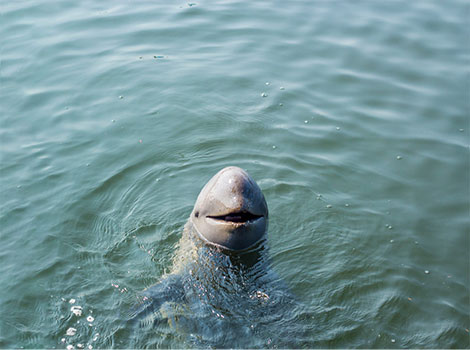
| Attributes | Quick facts |
|---|---|
| Size | 6–8 feet (1.8–2.4 m) |
| Weight | 200–440 lbs (90–200 kg) |
| Lifespan | 25–30 years |
| Habitat | Coastal waters, rivers, and estuaries in South and Southeast Asia |
| Diet | Fish, crustaceans, and cephalopods |
| Social Structure | Small pods (2–6 individuals) |
| Conservation | Endangered |
Fun fact: These dolphins are known for their playful “spitting” behavior, which they use to herd fish or communicate with each other!
Having discovered the intriguing mammals that start with ‘I,’ let’s now shift our attention to reptiles.
Reptiles that start with I
Reptiles starting with “I” showcase fascinating diversity. From the striking Indian cobra to the patterned Indian star tortoise, these species highlight the wonders of the reptile world.
| Inland Taipan | Italian Wall Lizard | Inland Bearded Dragon |
| Ibiza Wall Lizard | Indigo Snake | Indian Python |
31. Inland Taipan
The Inland Taipan (Podarcis siculus) is a small, lively reptile found across Italy and parts of southern Europe. These lizards are about 6 to 9 inches long, including their tail, and are known for their sleek, slender bodies. Their scales are typically green with brown or black markings, though colors can vary depending on where they live. Their long tail and sharp claws make them excellent climbers and fast runners.
These lizards live in sunny, rocky habitats like walls, gardens, and open fields. They thrive in Mediterranean climates, enjoying warm, dry weather. Italian Wall Lizards are omnivores, feasting on insects, spiders, and plants. They’re quick to dart away when they sense danger, but you might spot them basking in the sun or hiding among rocks.
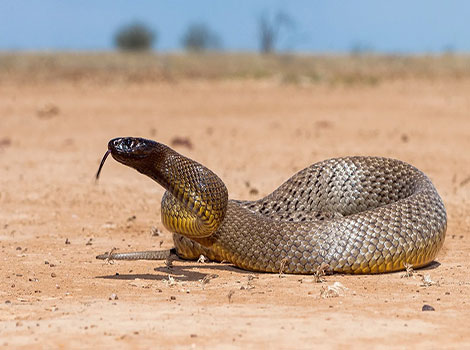
| Attributes | Quick facts |
|---|---|
| Size | 5.9–8.2 feet (1.8–2.5 m) |
| Weight | 2.2–4.4 lbs (1–2 kg) |
| Lifespan | 10–15 years |
| Habitat | Arid regions, clay plains, and scrublands in central Australia |
| Diet | Small mammals, primarily rodents |
| Social Structure | Solitary |
| Conservation | Least Concern |
Fun fact: Italian Wall Lizards are amazing at adapting! They can thrive in new environments, and they’ve even been introduced to places far from their original homes!
32. Italian Wall Lizard
The Italian Wall Lizard (Podarcis siculus) is a small, slender lizard native to the Mediterranean, particularly Italy, but has also spread to new areas like North America. Adults measure around 7.1 to 9.8 inches long (including their tail, which makes up most of their length) and weigh just 0.4 to 0.7 ounces. They’re usually bright green with dark patterns on their back and sides, though some may appear brown or gray depending on their surroundings.
These lizards thrive in sunny, rocky areas, gardens, and scrublands, preferring warm, temperate climates. They are diurnal, basking in the sun during the day and darting quickly across walls or rocks. Italian Wall Lizards are omnivorous, eating insects, spiders, and plants. During spring, females lay 3–10 eggs in hidden spots like under rocks, and the hatchlings are independent right away.
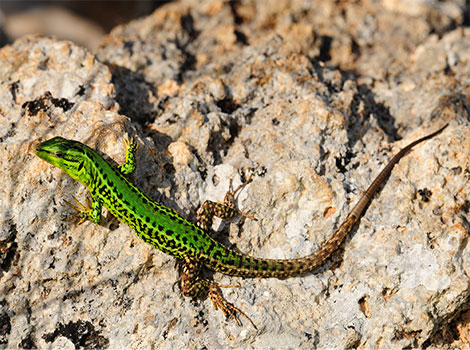
| Attributes | Quick facts |
|---|---|
| Size | 6–9 inches (15–23 cm) including tail |
| Weight | 0.2–0.4 oz (5–10 grams) |
| Lifespan | 5–7 years |
| Habitat | Rocky areas, walls, gardens, and grasslands in Southern Europe |
| Diet | Insects, spiders, and small invertebrates |
| Social Structure | Solitary or small groups |
| Conservation | Least Concern |
Fun fact: Italian Wall Lizards are escape artists! They can regrow their tails after losing them to predators, and they’ve successfully adapted to urban areas and new environments worldwide!
33. Inland Bearded Dragon
The Inland Bearded Dragon (Pogona vitticeps), also known as the Central Bearded Dragon, is a medium-sized lizard native to Australia’s arid and semi-arid regions, like deserts, shrublands, and savannahs. These lizards are 18 to 24 inches long, including their muscular tails, and weigh about 10 to 18 ounces. Their color ranges from tan to yellow, orange, or brown, helping them blend into their surroundings. They are known for their spiny “beard,” which they puff out to show dominance or when threatened.
Bearded dragons are omnivores, eating insects like crickets and mealworms, as well as plants, fruits, and flowers. They are diurnal, basking in the sun to stay warm, and show fascinating behaviors like “arm waving” to signal submission or “head bobbing” to assert dominance. In spring, females lay 15–25 eggs in sandy burrows, and the independent hatchlings start foraging right away.
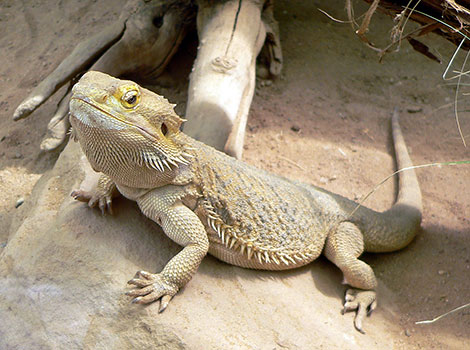
| Attributes | Quick facts |
|---|---|
| Size | 13–24 inches (33–61 cm) |
| Weight | 0.6–1.1 lbs (250–500 grams) |
| Lifespan | 8–12 years |
| Habitat | Arid and semi-arid regions, including deserts, shrublands in central Australia |
| Diet | Insects, small vertebrates and fruits |
| Social Structure | Solitary |
| Conservation | Least Concern |
Fun fact: Bearded dragons can change the color of their beard or body to express mood or regulate their temperature—a handy trick for communication and survival!
34. Ibiza Wall Lizard
The Ibiza Wall Lizard (Podarcis pityusensis) is a small, vibrant lizard native to Ibiza and the Pityusic Islands in the Mediterranean. Adults measure around 6.7 to 8 inches long, including their tapering tails, and weigh just 0.35 to 0.6 ounces. Their coloration is highly variable, with shades of green, brown, or striking turquoise, often depending on their habitat, making them a beautiful sight in their natural environment.
These lizards thrive in rocky areas, grasslands, and even near human settlements, enjoying the region’s Mediterranean climate with hot summers and mild winters. They are active during the day, foraging for insects, spiders, and occasionally fruits and seeds. Agile climbers, they are often seen darting across rocks and plants. In spring, females lay 2–8 eggs in warm, hidden spots, and the hatchlings are independent from birth.
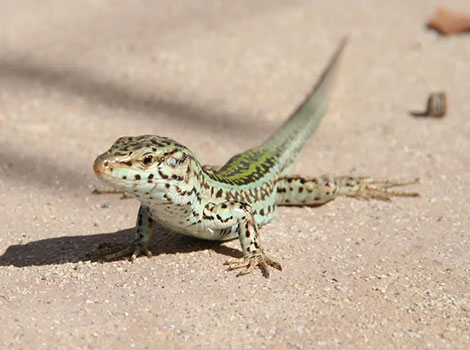
| Attributes | Quick facts |
|---|---|
| Size | 6–8 inches (15–20 cm) |
| Weight | 0.2–0.4 oz (5–10 grams) |
| Lifespan | 5–7 years |
| Habitat | Rocky areas, walls, and grasslands on Ibiza and neighboring island |
| Diet | Insects, spiders, fruits, and flower |
| Social Structure | Solitary or small groups |
| Conservation | Least Concern |
Fun fact: Ibiza Wall Lizards play an essential role in their ecosystem by dispersing seeds from the fruits they eat, helping local plants thrive!
35. Indigo Snake
The Indigo Snake (Drymarchon couperi), also known as the Eastern Indigo Snake, is the longest native snake in the United States, growing up to 5.9 to 8.6 feet long and weighing 3.3 to 11 pounds. This robust snake has shiny, iridescent black scales that gleam with bluish-purple hues in sunlight, and some individuals display reddish-orange coloring around their chin and throat.
Native to the southeastern United States, these snakes thrive in pine flatwoods, hardwood forests, and sandhill habitats. They are diurnal and non-venomous, feeding on a wide variety of prey, including rodents, birds, frogs, and even venomous snakes like rattlesnakes. They subdue prey by overpowering it with their jaws and swallowing it whole. Females lay 6–12 eggs in summer, and the hatchlings are independent from birth.
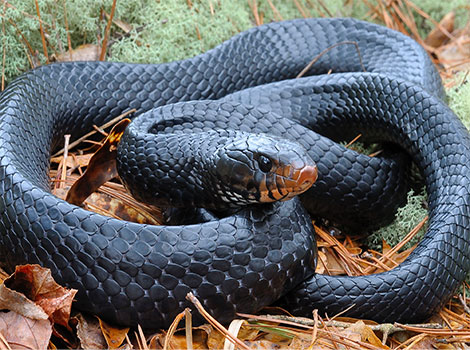
| Attributes | Quick facts |
|---|---|
| Size | 5–8.5 feet (1.5–2.6 m) |
| Weight | 3–10 lbs (1.4–4.5 kg) |
| Lifespan | 15–25 years |
| Habitat | Pine forests, scrublands, and wetlands in the southeastern United States |
| Diet | Small mammals, birds, reptiles, amphibians, and other snakes |
| Social Structure | Solitary |
| Conservation | Near Threatened |
Fun fact: The Indigo Snake is an apex predator, helping to control populations of smaller snakes, including venomous species, making it a vital part of its ecosystem!
36. Indian Python
The Indian Python (Python molurus), also called the Black-tailed Python, is a massive and muscular snake native to the Indian subcontinent. These snakes can grow 10 to 20 feet long and weigh between 150 to 200 pounds. They have a yellowish or brownish base color with irregular dark brown or black blotches, making them blend into their surroundings. Their broad, triangular heads and heat-sensitive pits along the upper jaw help them detect warm-blooded prey, even in complete darkness.
Indian Pythons live in diverse habitats, from forests and swamps to grasslands and rocky areas. They are nocturnal and semi-aquatic, often found near water bodies, where they can swim effortlessly. They hunt by ambushing their prey, constricting it with their powerful coils, and swallowing it whole. Females lay 20–100 eggs in hidden spots and protect them by coiling around them to regulate temperature. Once the eggs hatch, the young are independent.
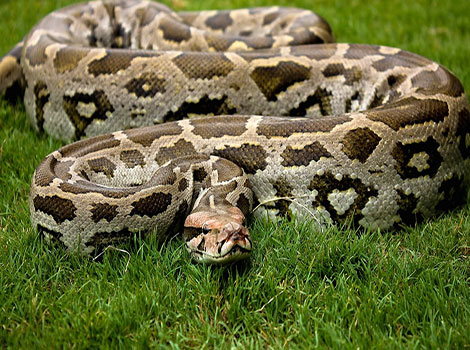
| Attributes | Quick facts |
|---|---|
| Size | 10–20 feet (3–6 m) |
| Weight | 70–150 lbs (32–68 kg) |
| Lifespan | 20–30 years |
| Habitat | Forests, grasslands, swamps, and rocky foothills in South and Southeast Asia |
| Diet | Mammals, birds, and reptiles |
| Social Structure | Solitary |
| Conservation | Near Threatened |
Fun fact: Indian Pythons are incredible swimmers and can stay underwater for up to 30 minutes to hunt or avoid predators!
From reptiles, we now take flight to explore birds that start with ‘I,’ showcasing their unique charm and diversity.
Birds that start with I
Birds starting with “I” may be rare, but they are remarkable. The Xenops, a small bird found in Central and South America, stands out with its unique behavior of foraging along tree trunks. This avian marvel adds intrigue to the birding world.
| Ibis | Indian Peafowl | Island Canary |
| Ivory-billed Woodpecker |
37. Ibis
The Ibis is a medium-sized wading bird from the family Threskiornithidae, with notable species including the Sacred Ibis (Threskiornis aethiopicus) and the American White Ibis (Eudocimus albus). They are typically 22 to 30 inches long, with a wingspan of 35 to 41 inches, and weigh between 1.5 to 3 pounds. Their appearance varies by species, but they generally have long legs for wading and a curved bill for probing mud or sand. For instance, the Sacred Ibis has a white body with black wingtips and a black, featherless head, while the American White Ibis is mostly white with a bright red face, legs, and beak.
Ibises thrive in wetlands, marshes, and coastal areas, preferring tropical and subtropical climates but adapting well to temperate zones. They are social birds, often seen in flocks, and are known for their communal nesting. They feed on small aquatic organisms like fish, insects, and crustaceans, using their specialized bills to forage in shallow waters. Both parents care for their chicks, which are born helpless and rely on regurgitated food until they can forage.
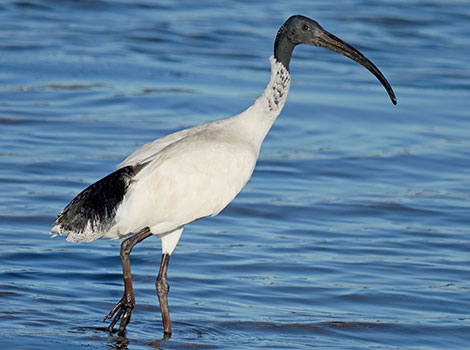
| Attributes | Quick facts |
|---|---|
| Size | 18–41 inches (45–105 cm), depending on the species |
| Weight | 1.1–4.4 lbs (0.5–2 kg) |
| Lifespan | 15–20 years |
| Habitat | Wetlands, marshes, mangroves, and grasslands worldwide |
| Diet | Small fish, insects, crustaceans, and plant material |
| Social Structure | Flocks or colonies |
| Conservation | Least Concern |
Fun fact: In ancient Egypt, the Sacred Ibis was a symbol of wisdom and associated with Thoth, the god of knowledge and writing!
38. Indian Peafowl
The Indian Peafowl (Pavo cristatus), also known as the Blue or Common Peafowl, is a large and stunning bird from the Phasianidae family. Males (peacocks) measure up to 86 inches with their train, while females (peahens) are smaller, around 35 to 43 inches. Peacocks weigh between 8.8 to 13 pounds, and peahens weigh 6.6 to 8.8 pounds. The males are famous for their iridescent blue-green plumage and their long, eye-patterned train used in courtship displays. Females are brownish-green, lacking the males’ elaborate train.
Indian Peafowl live in forests, grasslands, and even urban parks, favoring tropical and subtropical climates. They forage on the ground, eating seeds, grains, insects, and small reptiles. Active during the day, they roost in trees at night for safety. During the breeding season, peacocks display their trains and vocalize to attract mates. Females lay 3–5 eggs, incubate them, and teach the chicks—who are precocial and follow their mother soon after hatching—how to forage.
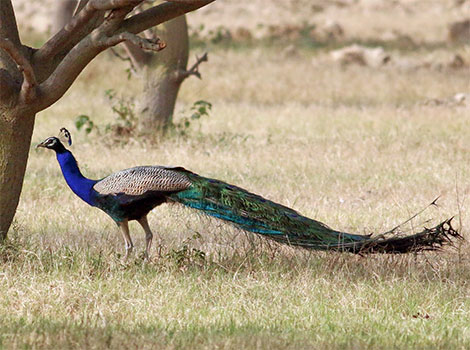
| Attributes | Quick facts |
|---|---|
| Size | 35–50 inches (90–130 cm) excluding tail feathers |
| Weight | 8–13 lbs (3.5–6 kg) |
| Lifespan | 10–25 years |
| Habitat | Forests, grasslands, and agricultural areas in South Asia |
| Diet | Seeds, fruits, insects, and small reptiles |
| Social Structure | Groups or solitary |
| Conservation | Least Concern |
Fun fact: The peacock’s iconic train isn’t part of its tail but elongated upper tail coverts, which are shed and regrown every year!
39. Island Canary
The Island Canary (Serinus canaria), also known as the Atlantic Canary or Common Canary, is a small, vibrant bird native to the Canary Islands, Madeira, and the Azores. These birds measure around 4.7 to 5.5 inches in length and weigh between 0.5 to 0.9 ounces. Their yellow-green plumage, often streaked with brown or gray, is more vivid in males. They have a short, conical beak, perfect for cracking seeds, and are renowned for their melodious songs.
Island Canaries thrive in temperate and subtropical climates, living in forests, gardens, and scrublands. They are diurnal and social, often seen in flocks outside the breeding season. They forage for seeds, fruits, and small insects, using their sharp beaks to pluck or crack food. During breeding, females build cup-shaped nests and lay 3–5 eggs. Both parents care for the chicks, feeding them regurgitated food until they can fend for themselves.
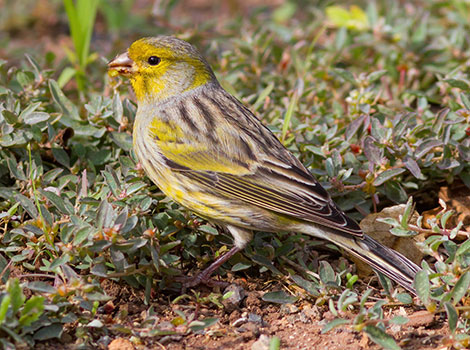
| Attributes | Quick facts |
|---|---|
| Size | 4.7–5.1 inches (12–13 cm) |
| Weight | 0.5–0.7 oz (13–20 grams) |
| Lifespan | 8–10 years |
| Habitat | Woodlands, gardens, and shrublands in the Canary Islands, Azores, and Madeira |
| Diet | Seeds, fruits, and small insects |
| Social Structure | Small flocks or pairs |
| Conservation | Least Concern |
Fun fact: The Island Canary is the wild ancestor of the domestic canary, famous for its range of colors and beautiful singing!
40. Ivory-billed Woodpecker
The Ivory-billed Woodpecker (Campephilus principalis) is a large, striking bird from the Picidae family. Measuring 19 to 21 inches in length with a wingspan of 30 to 31.5 inches, it weighs between 16 to 20 ounces. It has a black body with bold white wing patches and distinctive markings on its back. Males feature a bright red crest, while females have a black one. Its powerful, chisel-like bill, resembling ivory, is ideal for drilling into hardwood trees.
Historically found in old-growth forests of the southeastern United States and Cuba, this woodpecker prefers warm, humid, swampy regions with large trees. It feeds on beetle larvae, ants, fruits, and nuts, using its strong bill to strip bark and probe deep into wood. Known for its loud calls and rapid drumming, it is usually seen alone or in pairs. They nest in tree cavities, where both parents care for their chicks until they fledge.
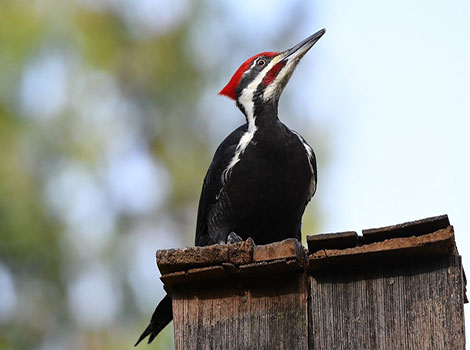
| Attributes | Quick facts |
|---|---|
| Size | 18–20 inches (45–51 cm) |
| Weight | 1–1.25 lbs (450–570 grams) |
| Lifespan | Estimated 10–15 years |
| Habitat | Swamps, dense forests, and wetlands in the southeastern United States and Cuba |
| Diet | Beetle larvae, insects, and fruits |
| Social Structure | Pairs or small family groups |
| Conservation | Critically Endangered |
Fun fact: Known as the “Holy Grail” of birdwatching, the Ivory-billed Woodpecker is thought to be extinct, but occasional unconfirmed sightings keep the hope of its survival alive!
Leaving birds behind, we now dive into the waters to discover fish that start with ‘I.’
Fishes that start with I?
Fishes name beginning with “I” include some fascinating species below.
| Icefish | Indian Glassy Fish |
41. Icefish
The Icefish, belonging to the family Channichthyidae, is a fascinating inhabitant of the frigid waters around Antarctica. These medium-sized fish typically range from 12 to 25 inches in length and weigh between 2.2 to 5.5 pounds. Their pale, translucent skin and lack of scales make them unique, but their most remarkable feature is their blood, which lacks hemoglobin, giving it a whitish appearance. Instead, they rely on oxygen dissolved in their plasma, a trait that suits the oxygen-rich, subzero Antarctic waters.
Icefish are carnivores, feeding on krill, amphipods, and small fish. They are mostly benthic but can swim in midwater to hunt prey using stealth and sharp teeth. During the Antarctic summer, females lay large eggs in rocky crevices, sometimes guarding them until they hatch. Juveniles are independent from birth.
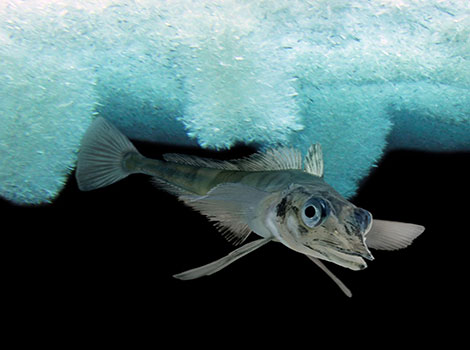
| Attributes | Quick facts |
|---|---|
| Size | 6–25 inches (15–63 cm) |
| Weight | 1–5 lbs (0.5–2.3 kg) |
| Lifespan | Estimated 8–10 years |
| Habitat | Cold waters of the Southern Ocean around Antarctica |
| Diet | Krill, small fish, and plankton |
| Social Structure | Solitary or small groups |
| Conservation | Not Evaluated |
42. Indian Glassy Fish
The Indian Glassy Fish (Parambassis ranga), also called the Glassfish, is a small, fascinating freshwater species native to rivers, streams, and ponds in South and Southeast Asia, especially in India, Bangladesh, and Myanmar. These fish grow up to 3 inches long, with some reaching 4 inches, and weigh less than 0.5 ounces. Their transparent bodies reveal internal organs, giving them a unique “glassy” appearance, which serves as natural camouflage in the wild.They thrive in tropical climates with warm waters and prefer slow-moving or still habitats with lots of vegetation. Glassy fish are peaceful, social creatures often found in schools. They are omnivores, feeding on tiny crustaceans, plankton, worms, and plant matter. During spawning, females lay eggs on submerged plants, and males guard them until they hatch after 2–3 days. The fry are independent from birth.
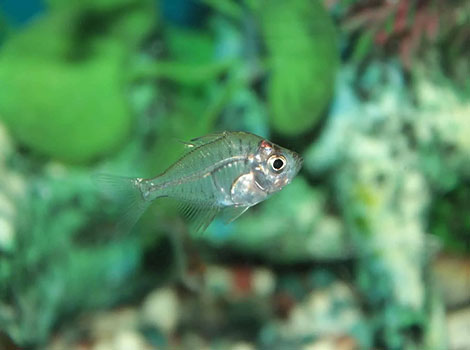
| Attributes | Quick facts |
|---|---|
| Size | 2–3 inches (5–8 cm) |
| Weight | Less than 0.1 oz (a few grams) |
| Lifespan | 3–4 years |
| Habitat | Freshwater rivers, streams, and ponds in South Asia |
| Diet | Small insects, crustaceans, and plankton |
| Social Structure | Small schools |
| Conservation | Least Concern |
Fun fact: The Indian Glassy Fish’s transparency is a clever adaptation to avoid predators, making it nearly invisible in its natural environment!
From the depths of the water, we transition to amphibians starting with ‘I,’ exploring their unique dual lifestyles and fascinating traits.
Amphibians that start with I
Amphibians starting with ‘I’ showcase fascinating traits and unique life cycles, thriving in both water and land environments.
| Indian Cricket Frog | Imitator Salamander | Iberian Spadefoot Toad |
| Idaho Giant Salamander | Ishikawa’s Frog |
43. Indian Cricket Frog
The Indian Cricket Frog (Minervarya agricola), also called the Field Frog, is a small amphibian native to South Asia, particularly India. Adults are around 1.2 to 2.4 inches long and weigh less than 0.5 ounces. Their brown or olive-green coloration, with dark spots or stripes, provides excellent camouflage in muddy or grassy areas. During the breeding season, males may display bright colors and develop vocal sacs used for calling.
These frogs are found in wetlands, paddy fields, grasslands, and gardens, thriving in tropical climates near water bodies. They are nocturnal, becoming active at dusk to hunt insects like crickets, ants, and termites with their sticky tongues. During the monsoon season, males call with a distinct cricket-like sound to attract mates. Females lay hundreds of eggs in water, which hatch into tadpoles that grow into froglets within weeks, without parental care.
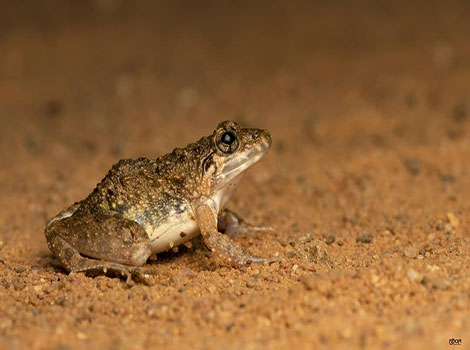
| Attributes | Quick facts |
|---|---|
| Size | 1–1.5 inches (2.5–4 cm) |
| Weight | Less than 0.5 oz (a few grams) |
| Lifespan | Estimated 3–5 years |
| Habitat | Wetlands, paddy fields, and grasslands in South Asia |
| Diet | Insects and small invertebrates |
| Social Structure | Solitary except during breeding |
| Conservation | Least Concern |
Fun fact: The Indian Cricket Frog’s calls are so convincing that they’re often mistaken for real crickets, helping them avoid predators that rely on sight!
44. Imitator salamander
The Imitator Salamander (Desmognathus imitator) is a small amphibian from the Plethodontidae family, commonly found in the cool, humid forests of the Appalachian Mountains. Measuring 2.5 to 4 inches long and weighing less than 0.3 ounces, these salamanders have dark brown to grayish-black coloring with lighter, irregular patterns that mimic more toxic salamanders to deter predators. They have a slim, elongated body, short legs, and a slightly flattened tail for movement in moist environments.
This lungless species breathes entirely through its skin and mouth lining, relying on constant moisture to survive. It is nocturnal, hiding under rocks, logs, or leaf litter during the day. As carnivores, they feed on small invertebrates, ambushing prey with precision. During late spring or summer, females lay eggs in moist areas and guard them until hatching. Hatchlings are independent from birth.
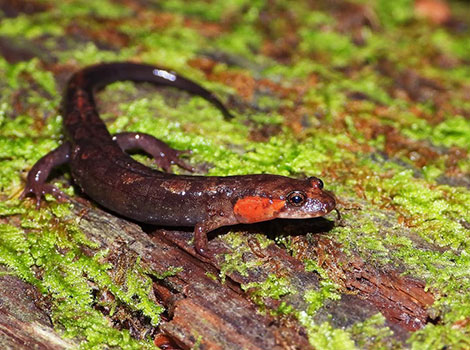
| Attributes | Quick facts |
|---|---|
| Size | 3–5 inches (7.5–12.5 cm) |
| Weight | Less than 0.5 oz (a few grams) |
| Lifespan | Estimated 10–15 years |
| Habitat | Moist forests and rocky areas in the Appalachian Mountains, USA |
| Diet | Insects, spiders, and small invertebrates |
| Social Structure | Solitary |
| Conservation | Least Concern |
Fun fact: The Imitator Salamander’s resemblance to toxic species like the Red-cheeked Salamander is a clever defense strategy, keeping predators at bay!
45. Iberian Spadefoot Toad
The Iberian Spadefoot Toad (Pelobates cultripes) is a medium-sized amphibian from the Pelobatidae family, native to the Iberian Peninsula and parts of southern France. Adults measure 2.4 to 4.7 inches long and weigh 1.1 to 2.2 ounces. Their olive-green to brown coloration, with dark blotches, provides excellent camouflage, and they have large bulging eyes with vertical pupils. A unique feature is their hardened, spade-like hind feet, which they use to dig burrows.
These nocturnal toads are active after heavy rains, especially during the breeding season. They inhabit sandy soils, open woodlands, and grasslands in Mediterranean climates, staying buried during dry periods. Carnivorous by nature, they hunt insects, spiders, and worms at night. Females lay up to 7000 eggs in long gelatinous strings in ponds or ditches during the rainy season. Tadpoles are independent and transform into toadlets within a few months.
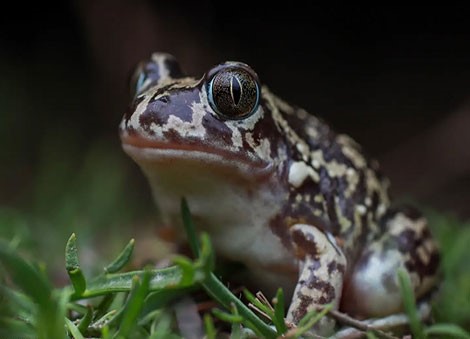
| Attributes | Quick facts |
|---|---|
| Size | 2.5–3 inches (6–8 cm) |
| Weight | 0.7–1 oz (20–30 grams) |
| Lifespan | Estimated 8–12 years |
| Habitat | Sandy or loose soils near temporary ponds in the Iberian Peninsula |
| Diet | Insects, worms, and small invertebrates |
| Social Structure | Solitary except during breeding |
| Conservation | Near Threatened |
Fun fact: The Iberian Spadefoot Toad can remain buried for months during droughts, emerging only when rains return to feed and breed!
46. Idaho giant salamander
The Idaho Giant Salamander (Dicamptodon aterrimus) is a medium to large amphibian from the Dicamptodontidae family, native to the moist, forested areas of Idaho and western Montana. Adults measure 6.5 to 13 inches long and weigh 2.1 to 3.5 ounces. They have a dark brown to black body with marbled patterns of lighter brown, gray, or tan, providing excellent camouflage. Larvae retain external gills for aquatic life, which are lost during metamorphosis into terrestrial adults, although some individuals remain in their larval state (neoteny).
These salamanders thrive in cool, temperate climates near clean, cold streams and lakes. They are nocturnal ambush predators, feeding on insects, worms, and small amphibians. Breeding occurs in cold waters, where females lay 100–200 eggs in protected underwater crevices and guard them until hatching. Larvae spend 1–3 years in water before transitioning to land.
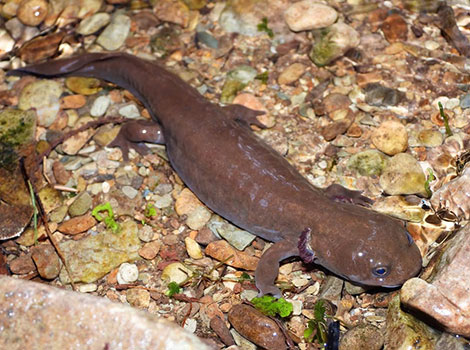
| Attributes | Quick facts |
|---|---|
| Size | 6.5–13 inches (17–33 cm) |
| Weight | 4–8 oz (113–227 grams) |
| Lifespan | Estimated 12–15 years |
| Habitat | Streams, lakes, and moist forests in Idaho, USA |
| Diet | Insects, worms, small amphibians, and fish |
| Social Structure | Solitary |
| Conservation | Near Threatened |
Fun fact: As a keystone species, the Idaho Giant Salamander helps balance its ecosystem by controlling insect populations and providing food for larger predators!
47. Ishikawa’s Frog
Ishikawa’s Frog (Odorrana ishikawae), often called a “living jewel” of Japan, is a medium-sized amphibian from the Ranidae family. Found only on the islands of Okinawa and Amami, these frogs inhabit subtropical, evergreen forests and clean, fast-flowing streams. Adults measure 2.4 to 4 inches in length and weigh 0.7 to 1.4 ounces. Their bright green bodies with irregular black blotches provide excellent camouflage among mossy rocks and vegetation.
These frogs are nocturnal, hiding under rocks and plants during the day to stay moist and safe from predators. Carnivorous by nature, they actively hunt insects and small invertebrates using their sticky tongues. Breeding occurs in freshwater streams, where females lay eggs in clusters attached to submerged rocks. The tadpoles are independent, feeding on algae and detritus until they metamorphose into froglets.
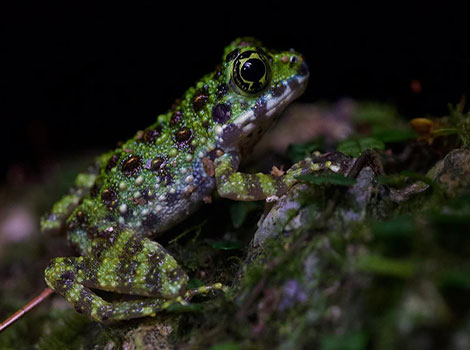
| Attributes | Quick facts |
|---|---|
| Size | 2–3 inches (5–8 cm) |
| Weight | 0.7–1.2 oz (20–35 grams) |
| Lifespan | Estimated 10–15 years |
| Habitat | Forested streams in Okinawa Island, Japan |
| Diet | Insects, worms, and small invertebrates |
| Social Structure | Solitary except during breeding |
| Conservation | Endangered |
Fun fact: Ishikawa’s Frog is one of Japan’s rarest frogs, admired for its vibrant colors and highly restricted range, making it a true natural treasure!
Moving on from amphibians, we now delve into the world of insects starting with ‘I,’ uncovering their remarkable adaptations and roles in nature.
Insects that start with I
Insects name beginning with “I” include some fascinating species. The Indian glassy fish, known for its translucent body, and the Indian threadfish, admired for its elongated fins, showcase the beauty and diversity of aquatic life.
| Io Moth | Indianmeal Moth | Ivy Bee |
48. Io Moth
The Io Moth (Automeris io) is a medium to large moth from the Saturniidae family, found across North America in habitats like forests, meadows, farmlands, and gardens. These moths have a wingspan of 2.5 to 3.5 inches and are known for their stunning hindwing eyespots that resemble owl eyes, scaring off predators. Males are bright yellow with feathery antennae, while females have brownish forewings.
Io Moth caterpillars feed on a wide variety of plants, including elm, oak, and maple, but adult moths do not eat as they lack functional mouthparts. Adults are nocturnal and live only 1–2 weeks, using their short lifespan to mate and lay eggs. Females deposit eggs in clusters on host plants, which hatch into caterpillars with stinging spines for defense. Caterpillars grow and pupate in silken cocoons among leaf litter, emerging as moths.
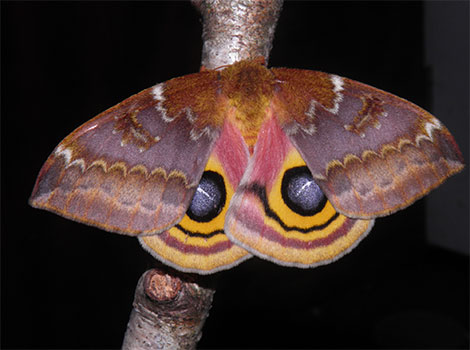
| Attributes | Quick facts |
|---|---|
| Size | Wingspan of 2.5–3.5 inches (6.3–9 cm) |
| Weight | Less than 0.1 oz (a few grams) |
| Lifespan | 1–2 weeks (as an adult moth) |
| Habitat | Forests, grasslands, and gardens in North and Central America |
| Diet | Caterpillars feed on leaves; adults do not eat |
| Social Structure | Solitary |
| Conservation | Not Evaluated |
Fun fact: Io Moth caterpillars have stinging spines that can cause painful skin irritation, making them a tough meal for predators!
49. Indianmeal Moth
The Indianmeal Moth (Plodia interpunctella) is a small but widespread moth from the Pyralidae family, often found in homes, warehouses, and stores where grains and dried foods are kept. Adults have a wingspan of 0.6 to 0.8 inches and a body length of about 0.3 to 0.4 inches. Their forewings are reddish-brown or coppery at the tips and grayish-white near the base, while the hindwings are a uniform grayish-white. They are weak fliers and are often seen resting on walls or ceilings.
Larvae feed on stored products such as grains, flour, dried fruits, nuts, and spices, chewing through packaging and contaminating food with silk webbing and droppings. Adults do not eat and live only 1–2 weeks, focusing on reproduction. Females lay 100–400 eggs near food, and the larvae hatch within days, feeding for 2–3 weeks before pupating.
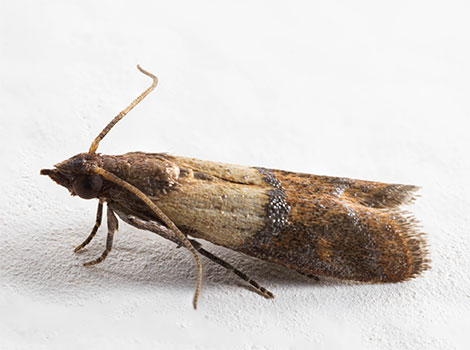
| Attributes | Quick facts |
|---|---|
| Size | Wingspan 0.6–0.8 inches (16–20 mm) |
| Weight | A few milligrams |
| Lifespan | 1–2 weeks (adult stage) |
| Habitat | Stored grains and food products worldwide |
| Diet | Grains, cereals, nuts, and dried fruits |
| Social Structure | Solitary |
| Conservation | Not Evaluated |
Fun fact: The Indianmeal Moth gets its name from its preference for “Indian meal,” an old term for cornmeal, not because it originated in India!
50. Ivy Bee
The Ivy Bee (Colletes hederae) is a small, slender-bodied bee from the Colletidae family, known for its close association with flowering ivy. Females measure 0.5 to 0.6 inches long, while males are slightly smaller at 0.4 to 0.5 inches. They have a black and yellow striped abdomen and a dense, tawny-haired thorax, with females sporting hairy hind legs for collecting pollen.
These bees thrive in temperate climates and are commonly found in gardens, parks, coastal areas, and meadows across southern England and mainland Europe. Active from late summer to early autumn, they forage exclusively on ivy flowers for nectar and pollen. Females dig burrows in sandy soil to lay their eggs in individual chambers, each provisioned with food for the larvae, which emerge as adults the following year.
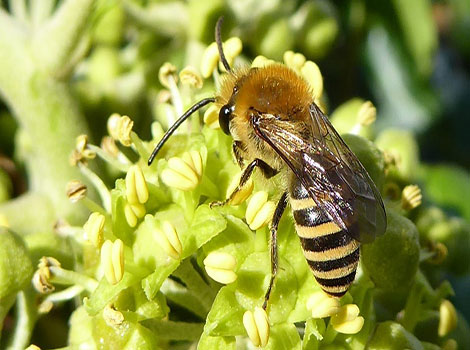
| Attributes | Quick facts |
|---|---|
| Size | 0.4–0.6 inches (10–15 mm) |
| Weight | A few milligrams |
| Lifespan | 6–8 weeks (adult stage) |
| Habitat | Grasslands, coastal areas, and gardens in Europe |
| Diet | Nectar and pollen, primarily from ivy flowers |
| Social Structure | Solitary but nests in large aggregations |
| Conservation | Least Concern |
Fun fact: The Ivy Bee was first described in 1993 and has quickly spread across Europe, becoming a familiar late-season pollinator in areas with plenty of ivy!
Leaving insects behind, we now explore other animals that start with ‘I,’ uncovering unique species from various corners of the animal kingdom.
Other animals that start with I
Animals starting with ‘I’ from various groups showcase unique adaptations and fascinating traits, adding to the incredible tapestry of life on our planet.
51. Isopod
Isopods are fascinating crustaceans belonging to the class Malacostraca, with over 10,000 species ranging from tiny woodlice to the enormous Giant Isopod (Bathynomus giganteus). Terrestrial isopods, like the Common Woodlouse, measure about 0.4 to 1 inch, while aquatic species vary from 0.4 inches to over 19 inches for the Giant Isopod, which can weigh up to 3.7 pounds. They have a flattened, segmented exoskeleton, seven pairs of legs, and two pairs of antennae, with some species able to roll into a ball for protection.
Isopods inhabit diverse environments, from moist soil and leaf litter to the deep sea. Terrestrial species feed on decaying organic matter, while marine isopods scavenge carrion or debris. They are mostly nocturnal, relying on damp habitats to breathe through gill-like structures or staying on the seafloor to scavenge. Females carry eggs in a brood pouch, where juveniles develop and emerge fully formed.
Size | 0.1–20 inches (0.3–50 cm)
Weight | A few milligrams to over 3 lbs (1.5 kg)
Lifespan | 2–5 years (terrestrial); up to 20 years
Habitat | Marine, freshwater, and terrestrial environments worldwide
Diet | Detritus, decaying organic matter, and occasionally live prey
Social Structure | Solitary or grouped
Conservation | Not Evaluated
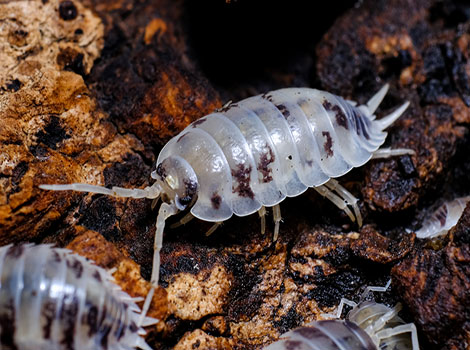
Fun fact: Giant Isopods can survive years without food, thanks to their slow metabolism and energy-efficient lifestyle!
FAQs:
What are Endangered Animals that Start With I?
Here are the top 5 Endangered Animals that Start With I:
- Ibiza Wall Lizard (Podarcis pityusensis): Endemic to the Balearic Islands, particularly Ibiza and Formentera, the Ibiza Wall Lizard faces threats from habitat loss due to urbanization, tourism development, and the introduction of invasive species such as rats and cats. Conservation efforts include habitat restoration, captive breeding programs, and monitoring of wild populations to ensure their survival.
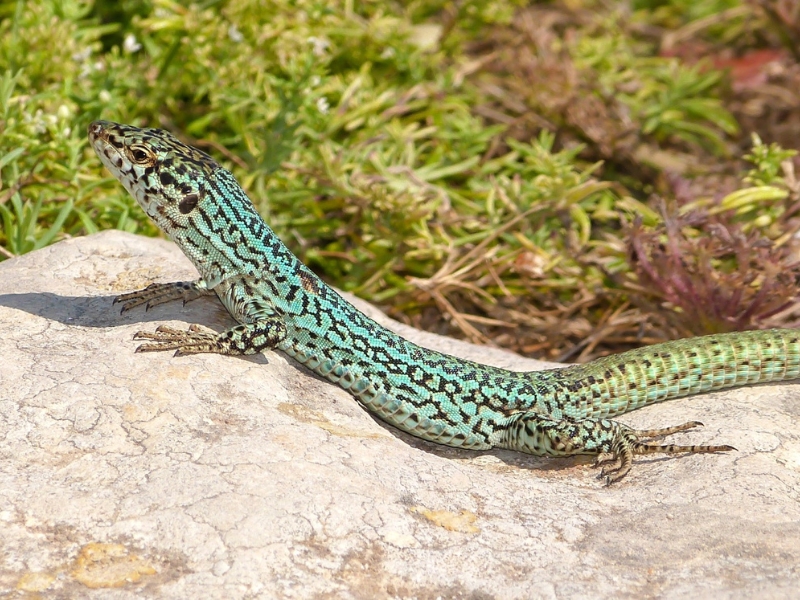
- Icefish (Chionodraco species): Icefish are a group of fish species found in the Southern Ocean surrounding Antarctica. They are vulnerable to climate change-induced habitat loss, overfishing, and pollution. Conservation efforts focus on marine protected areas, sustainable fishing practices, and research to better understand their ecological requirements and population dynamics.
- Indian Glassy Fish (Parambassis ranga): Wild populations of Indian Glassy Fish are threatened by habitat degradation, pollution, and overexploitation for the aquarium trade. Conservation efforts include captive breeding programs, habitat restoration, and regulation of the aquarium trade to ensure sustainable practices and reduce the impact on wild populations.
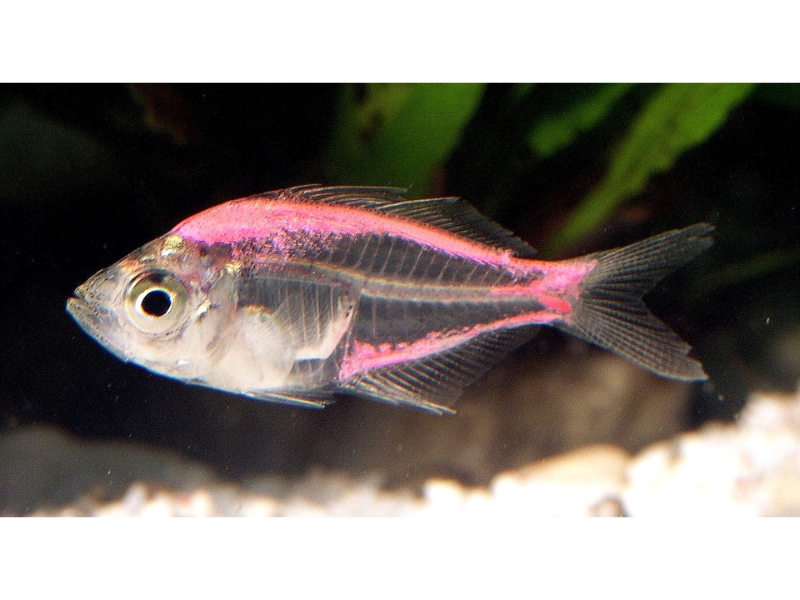
- Indian Star Tortoise (Geochelone elegans): Indian Star Tortoises are coveted for their attractive shell patterns and are often illegally collected for the exotic pet trade. Habitat loss and fragmentation further threaten their survival. Conservation initiatives focus on raising awareness about the illegal wildlife trade, establishing protected areas, and implementing captive breeding programs to reduce pressure on wild populations.
- Imperial Moth (Eacles imperialis): While not currently listed as endangered, Imperial Moths face habitat loss and fragmentation due to urbanization, agriculture, and deforestation. Conservation efforts include habitat preservation, restoration of native vegetation, and citizen science initiatives to monitor populations and distribution.
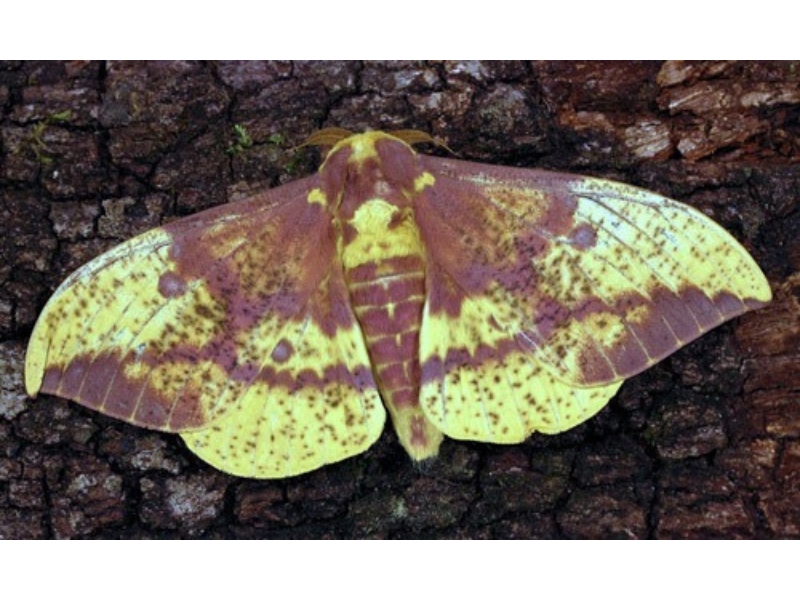
What are Aquatic Animals that Start With I?
Here are the top 5 Aquatic Animals that Start With I:
- Immortal Jellyfish (Turritopsis dohrnii): The Immortal Jellyfish, found in oceans worldwide, is known for its unique ability to revert to its juvenile polyp stage after reaching maturity, potentially allowing it to bypass death, thereby earning its name. This capability highlights an extraordinary form of biological immortality, offering insights into cellular regeneration and aging processes.
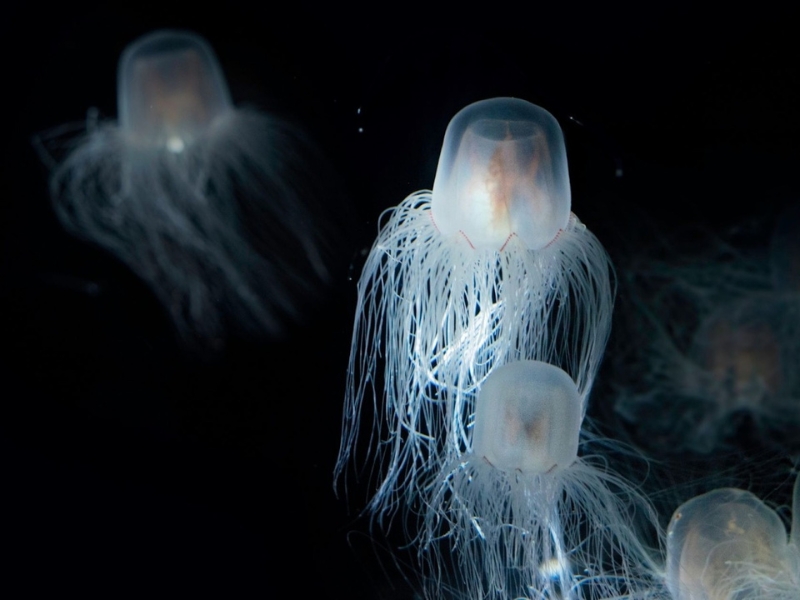
- Irukandji Jellyfish (Carukia barnesi): Found in tropical coastal waters of Australia and other regions, Irukandji Jellyfish are small and translucent, making them difficult to detect in the water. Despite their small size, they possess potent venom capable of causing Irukandji syndrome in humans, a condition characterized by severe pain, nausea, and other symptoms. Irukandji Jellyfish are important predators in marine ecosystems, controlling populations of small fish and invertebrates, although their presence can pose risks to swimmers and divers.
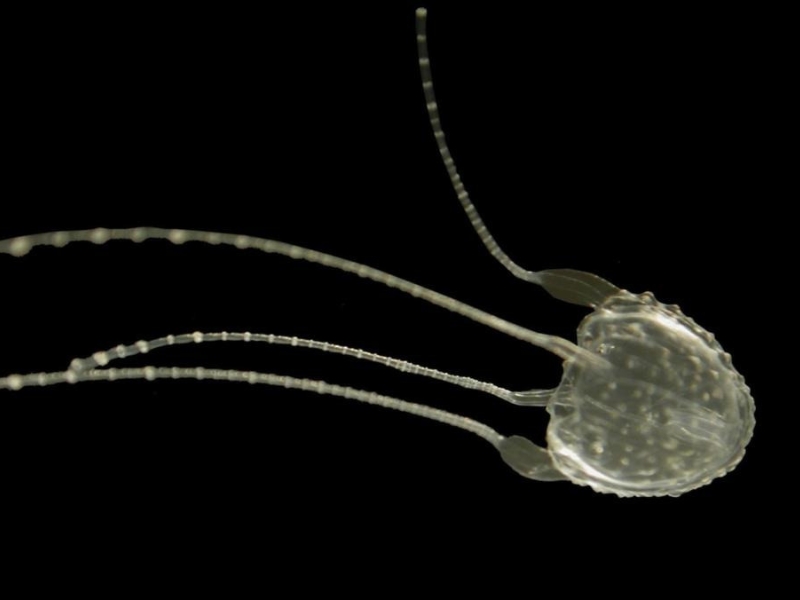
- Inia (Inia geoffrensis): Inia, or Amazon River dolphins, are freshwater dolphins endemic to the Amazon and Orinoco river basins in South America. They are highly adapted to their aquatic habitats, with elongated bodies, flexible necks, and reduced eyesight. Inia use echolocation to navigate murky waters and communicate with other dolphins. They play important ecological roles as top predators, regulating fish populations and contributing to nutrient cycling in river ecosystems. Despite their cultural significance and ecological importance, Inia face threats from habitat degradation, pollution, and accidental entanglement in fishing gear, highlighting the need for conservation efforts to protect their populations.
- Ichthyostega: Ichthyostega is an extinct Scientific Name of an early tetrapod that lived during the Late Devonian period (365 to 359 million years ago). It represents a key transitional form in the evolution of vertebrates from aquatic to terrestrial environments. Ichthyostega had limb-like appendages with digits, allowing it to support its weight on land, although it likely spent much of its time in shallow water habitats. Fossil evidence suggests that Ichthyostega was a voracious predator, feeding on fish and invertebrates, and played a crucial role in shaping early terrestrial ecosystems.
- Ivory Shell (Babylonia areolata): A species of sea snail found in the marine waters of Asia, particularly in the sandy and muddy bottoms of shallow coastal environments. Known for its beautifully patterned shell, it is not only a subject of interest among collectors but also plays a role in the culinary traditions of local cultures, illustrating the diverse uses and ecological roles of mollusks in marine ecosystems.
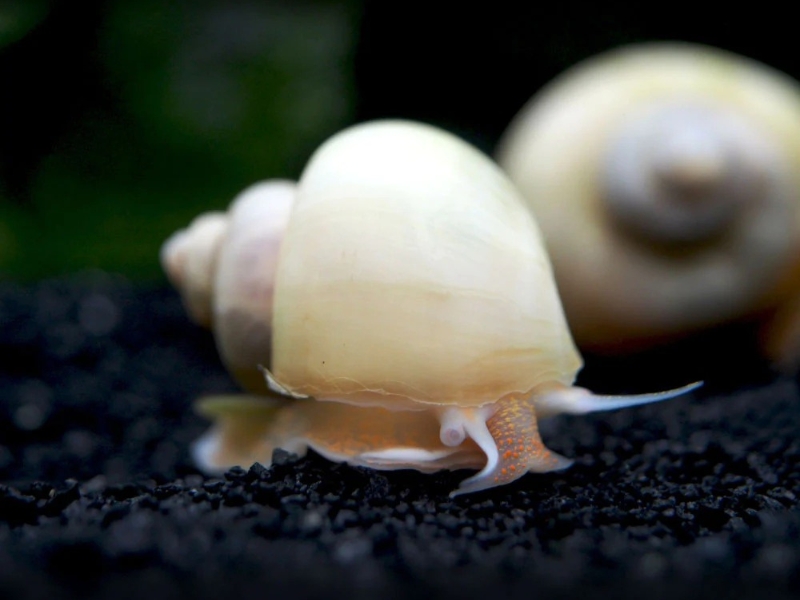
What are Pet Animals that Start With I?
Here are the top 5 pet Animals that Start With I:
- Indian Ringneck Parakeet (Psittacula krameri): Indian Ringneck Parakeets are popular pet birds known for their vibrant plumage, intelligence, and ability to mimic human speech. They require spacious cages, plenty of mental stimulation, and regular social interaction to thrive in captivity. Indian Ringneck Parakeets are playful and curious birds, capable of forming strong bonds with their owners and other household members.
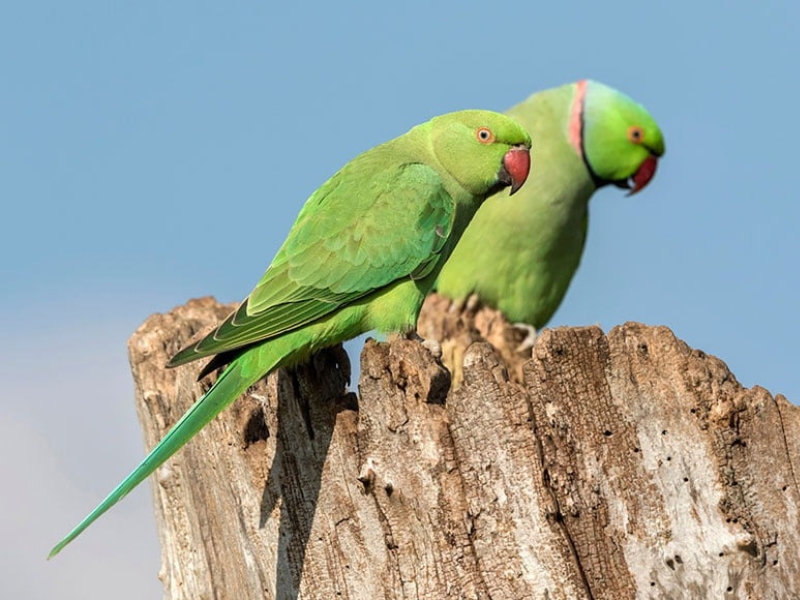
- Iguana (Iguanidae family): While not suitable for all owners due to their specific care requirements, iguanas are kept as pets by enthusiasts willing to provide proper housing, diet, and environmental enrichment. Green Iguanas are the most commonly kept species, known for their docile temperament and herbivorous diet. Pet iguanas require large enclosures with UVB lighting, a varied diet of leafy greens, vegetables, and fruits, and regular veterinary care to ensure their health and well-being.
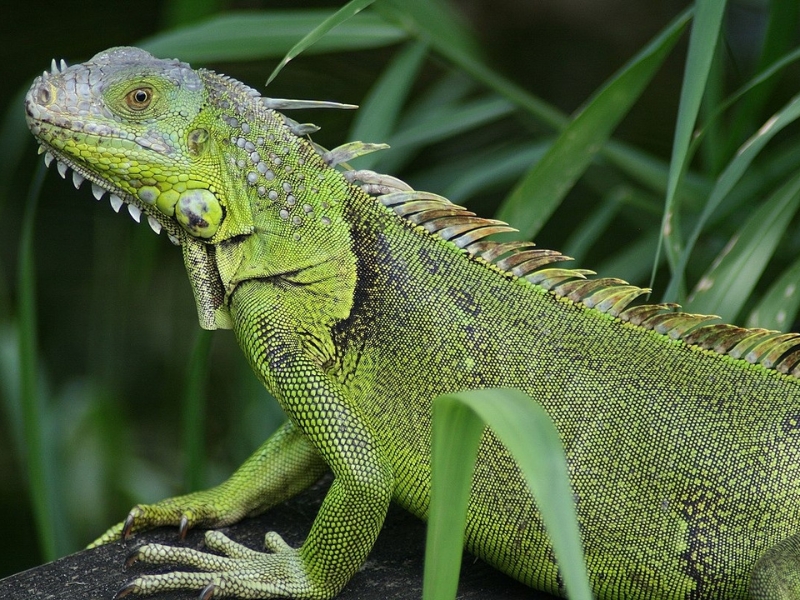
- Imperial Shih Tzu (Canis lupus familiaris): The Imperial Shih Tzu is a smaller version of the standard Shih Tzu, bred specifically for those seeking a more diminutive companion. Despite their reduced size, they retain the breed’s characteristic friendly and outgoing personality, along with its long, luxurious coat. These dogs are adaptable to apartment living and make excellent pets for families and individuals alike, requiring regular grooming and human interaction to thrive.

- Irish Terrier (Canis lupus familiaris): Irish Terriers are energetic and intelligent dogs known for their loyalty, courage, and affectionate nature. They make excellent family pets and companions for active individuals willing to provide regular exercise, mental stimulation, and training. Irish Terriers thrive in households with plenty of space to run and play, although they can adapt to apartment living with sufficient exercise and enrichment. Regular grooming and veterinary care are essential to maintain their health and well-being.

- Italian Greyhound (Canis lupus familiaris): Italian Greyhounds are elegant and affectionate dogs known for their slender build, graceful movements, and gentle temperament. They are well-suited to apartment living due to their small size and low exercise requirements, although they still enjoy regular walks and playtime. Italian Greyhounds form strong bonds with their owners and are sensitive to changes in their environment, requiring positive reinforcement training and socialization from an early age to thrive as pets.
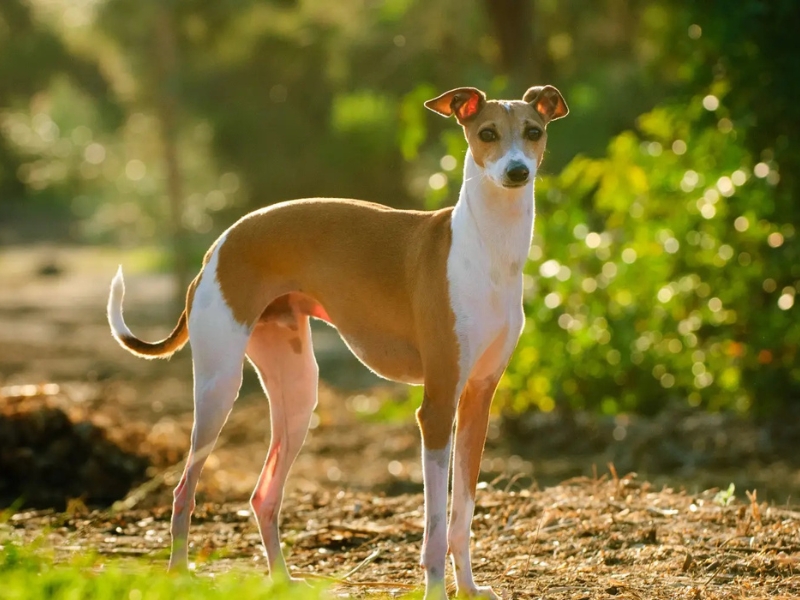
What are Wild Animals that Start With I?
Here are the top 5 popular Wild Animals that Start With I:
- Ibex (Capra ibex): Ibex are wild goats found in mountainous regions of Europe, Asia, and North Africa. They are adapted to rugged terrain, with specialized hooves for climbing steep cliffs and rocky slopes. Ibex inhabit alpine and subalpine habitats, where they feed on grasses, herbs, and shrubs. They are agile climbers and may form small herds for protection against predators such as wolves and lynx.
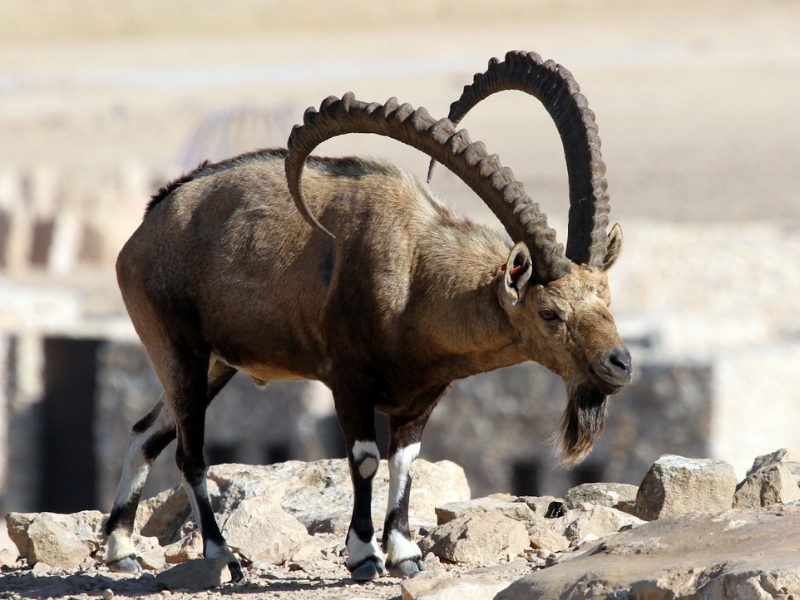
- Iberian Lynx (Lynx pardinus): The Iberian Lynx is a critically endangered wild cat species native to the Iberian Peninsula in Spain and Portugal. Characterized by its spotted coat, tufted ears, and short tail, the Iberian Lynx is a specialized predator, primarily hunting rabbits. Habitat destruction, a decline in rabbit populations, and human encroachment have led to a severe reduction in its numbers.
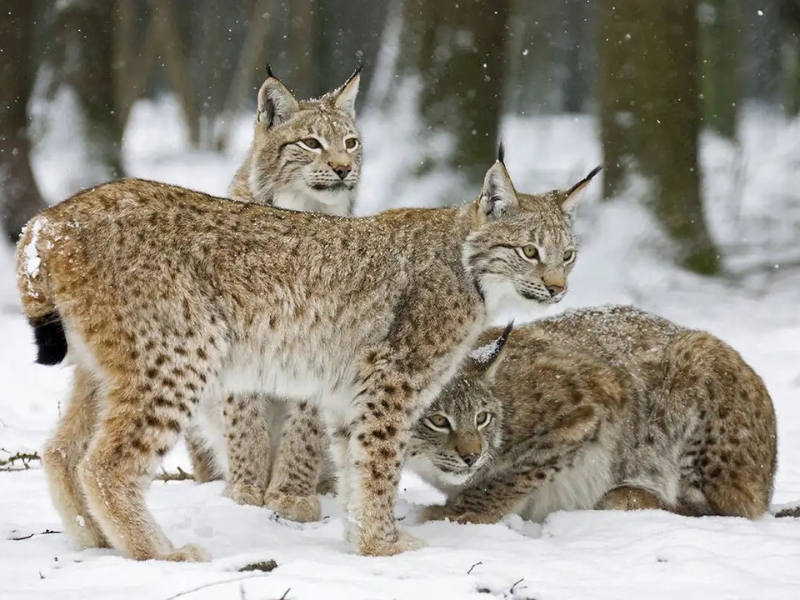
- Impala (Aepyceros melampus): Impalas are antelopes native to eastern and southern Africa, where they inhabit savanna habitats characterized by grasslands, woodlands, and shrublands. They are highly adaptable animals, capable of surviving in a variety of ecosystems, including semi-arid regions and national parks. Impalas are social creatures, forming large herds for protection against predators and communicating through vocalizations and visual signals.
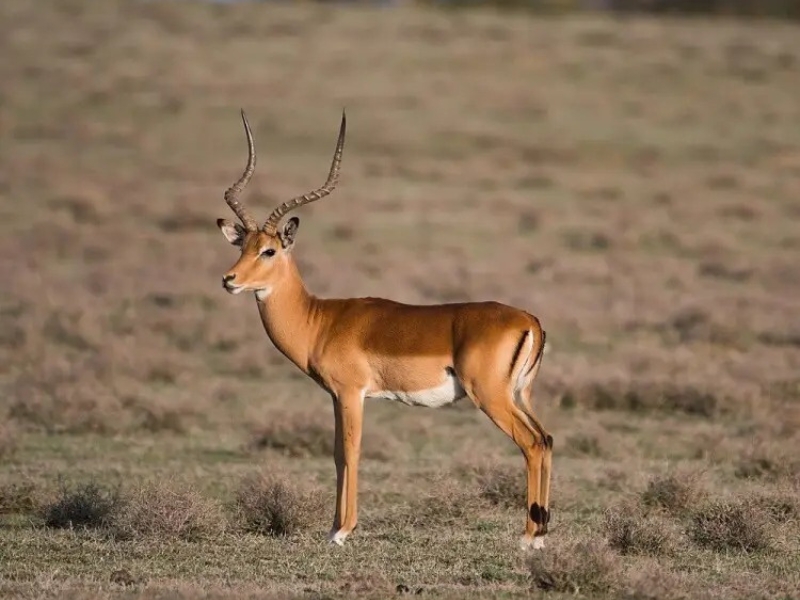
- Indian Elephant (Elephas maximus indicus): Indian elephants are found in diverse habitats across the Indian subcontinent, including tropical forests, grasslands, and wetlands. They are social animals, living in matriarchal herds led by an older female known as the matriarch. Indian elephants are herbivores, consuming a wide variety of plant material, including grasses, leaves, bark, and fruits. They play important ecological roles as seed dispersers and ecosystem engineers, shaping their habitat through their feeding and movement patterns.
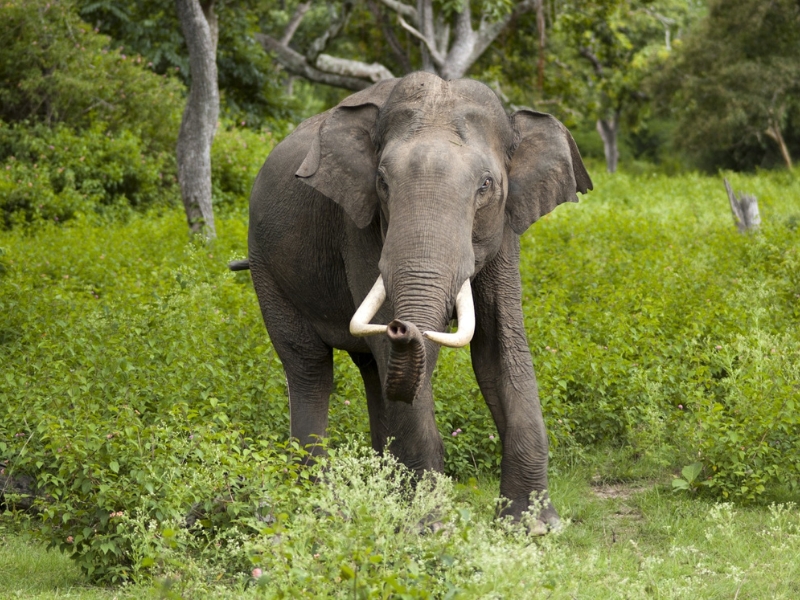
- Indri (Indri indri): The Indri is the largest living lemur, native to the rainforests of Madagascar. It is easily identifiable by its black and white fur and the absence of a tail. The Indri is known for its loud, haunting calls that resonate through the rainforest, used to communicate with other family groups and establish territory. Living primarily on a diet of leaves and fruits, this species plays a vital role in seed dispersal, aiding in forest regeneration.
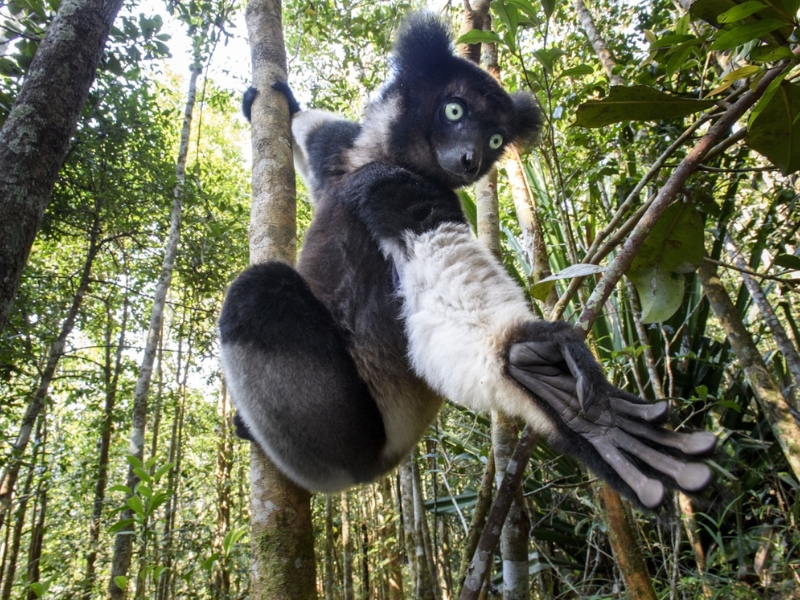
What are Zoo Animals that Start With I?
Here are the top 5 Zoo Animals that Start With I:
- Indian Rhino (Rhinoceros unicornis): The Indian Rhino is native to the grasslands and forests of the Indian subcontinent. Characterized by a single black horn and a unique armor-plated appearance due to its skin folds, the Indian Rhino is a significant attraction in zoos worldwide. These megaherbivores play a crucial role in their ecosystem by influencing the composition of vegetation and creating habitats suitable for other species.
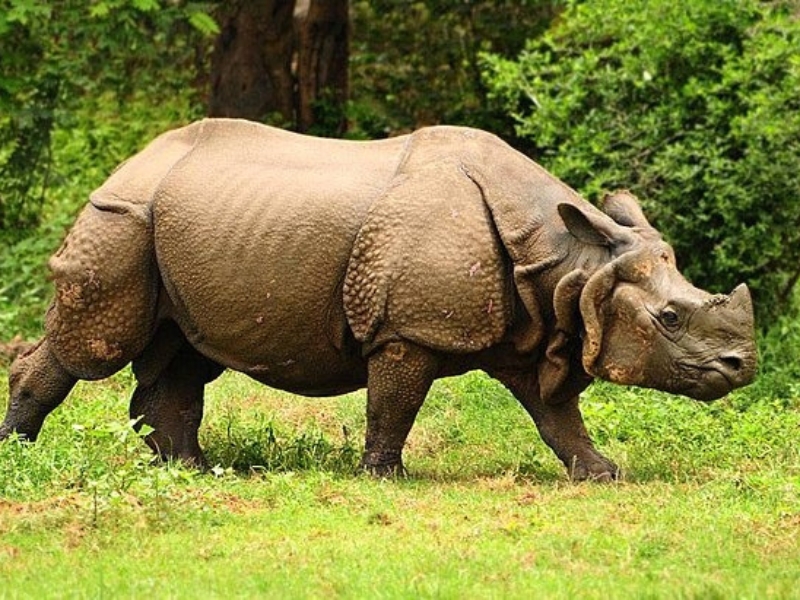
- Indian Peafowl (Pavo cristatus): Indian Peafowls, commonly known as peacocks, are often featured in zoos for their stunning plumage and elaborate courtship displays. They are native to the Indian subcontinent and are closely associated with cultural and religious symbolism in Hinduism and Buddhism.

- Island Fox (Urocyon littoralis): Endemic to the Channel Islands of California, the Island Fox is a small fox species that has been successfully reintroduced to several zoos as part of conservation breeding programs. These foxes are known for their diminutive size and unique adaptations to insular environments.
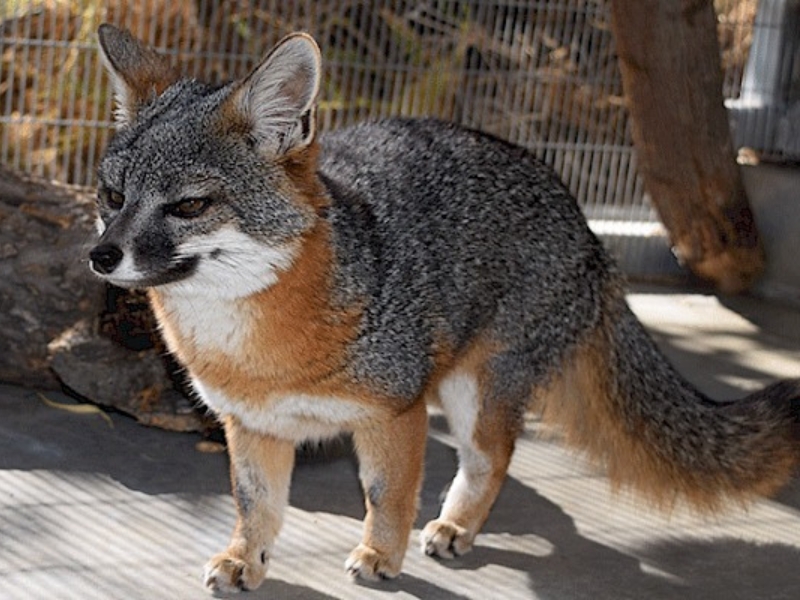
- Ivory-Billed Aracari (Pteroglossus azara): This small, colorful toucan is found in the rainforests of South America. With its vibrant plumage and distinctive large beak, the Ivory-Billed Aracari is a popular attraction in zoo aviaries.
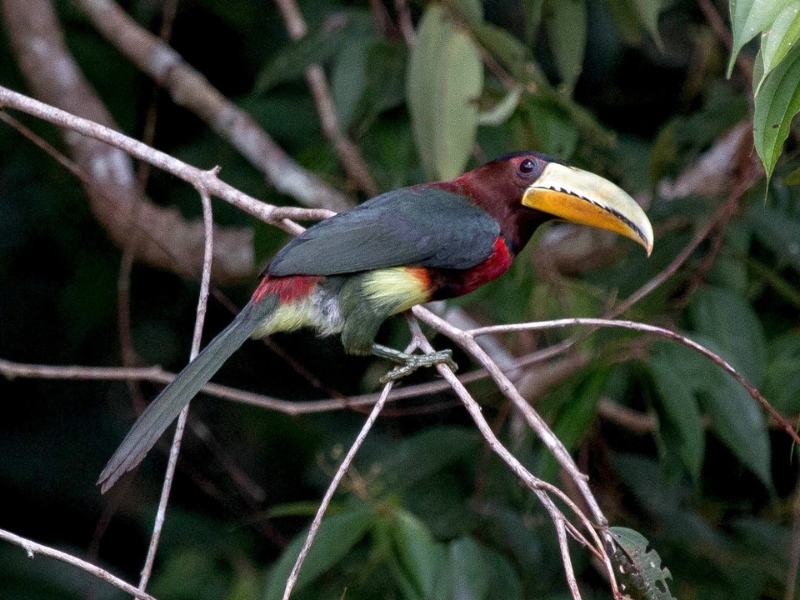
- Indochinese Tiger (Panthera tigris corbetti): As one of the most endangered big cat species, the Indochinese Tiger is a rare sight in zoos, but some institutions participate in conservation breeding programs to help ensure the species’ survival. These majestic predators are native to Southeast Asia and face severe threats from habitat loss and poaching for their body parts.
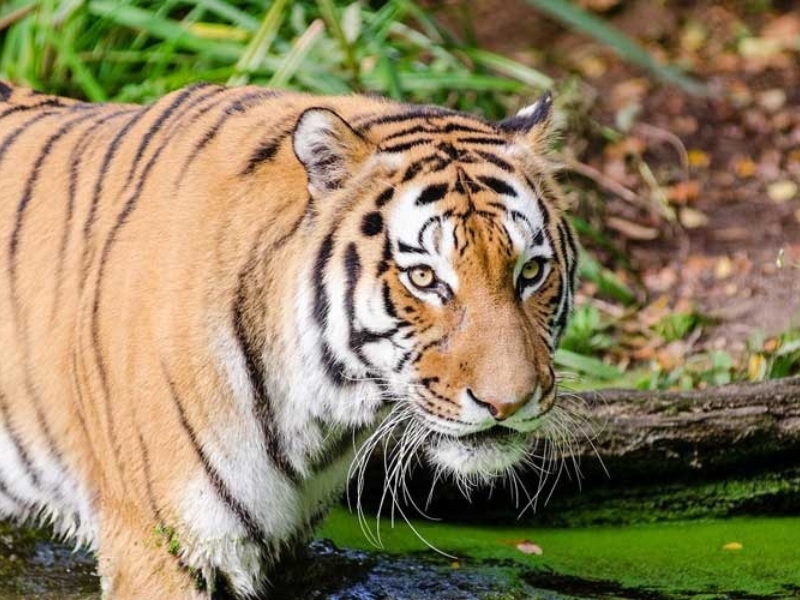
What are Desert Animals that Start With I?
Here are the top 5 Desert Animals that Start With I:
- Indian Desert Jird (Meriones hurrianae): The Indian Desert Jird is a rodent native to the arid regions of Northwestern India and parts of Pakistan. Adapted to life in the desert, it has developed behaviors and physical adaptations such as burrowing to escape the extreme heat and relying on seeds and vegetation that can withstand arid conditions.
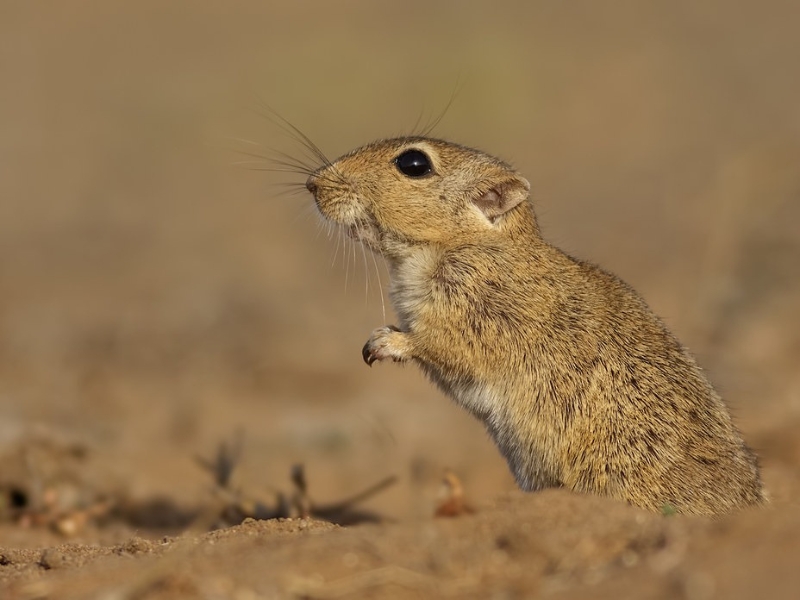
- Indian Palm Squirrel (Funambulus palmarum): Indian Palm Squirrels are common inhabitants of urban and rural areas across India and Sri Lanka, including semi-arid regions with scrub vegetation. These adaptable rodents are known for their agility and resourcefulness in finding food and shelter in desert environments.
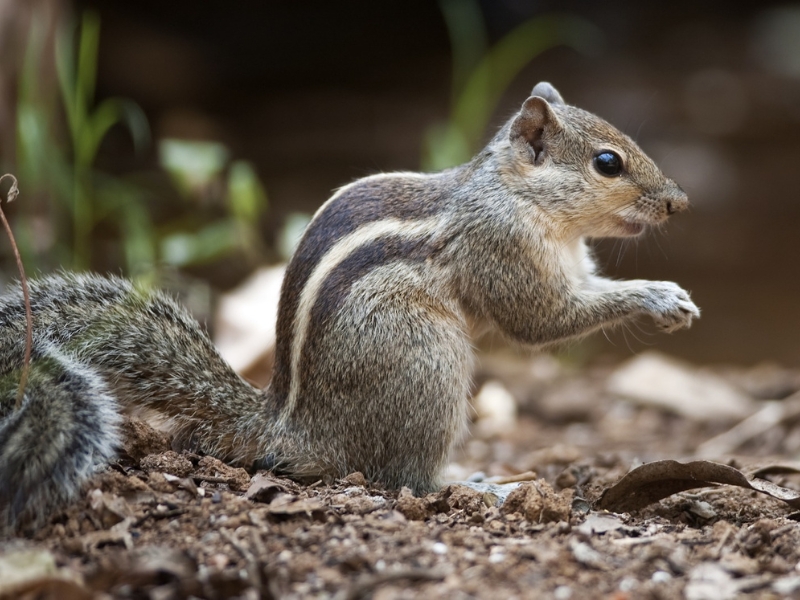
- Impala Lizard (Oplurus cuvieri): Though not as widely recognized as other desert dwellers, the Impala Lizard is a species found in the spiny deserts of Madagascar. Its name is a misnomer since it has no relation to the Impala antelope. This lizard is adapted to thrive in harsh, arid environments with its ability to blend into the desert landscape as a means of camouflage from predators.
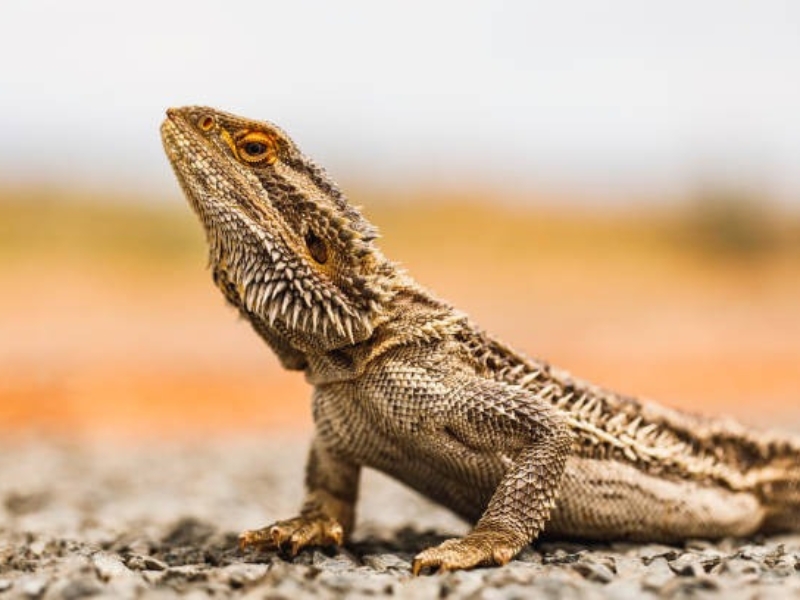
- Iberian Midwife Toad (Alytes cisternasii): The Iberian Midwife Toad inhabits the semi-arid landscapes of the Iberian Peninsula, including areas with rocky outcrops and sparse vegetation. Unique among amphibians for its adaptation to drier habitats, the male carries fertilized eggs wrapped around its legs until they are ready to hatch, ensuring their survival in a desert climate where water is scarce.
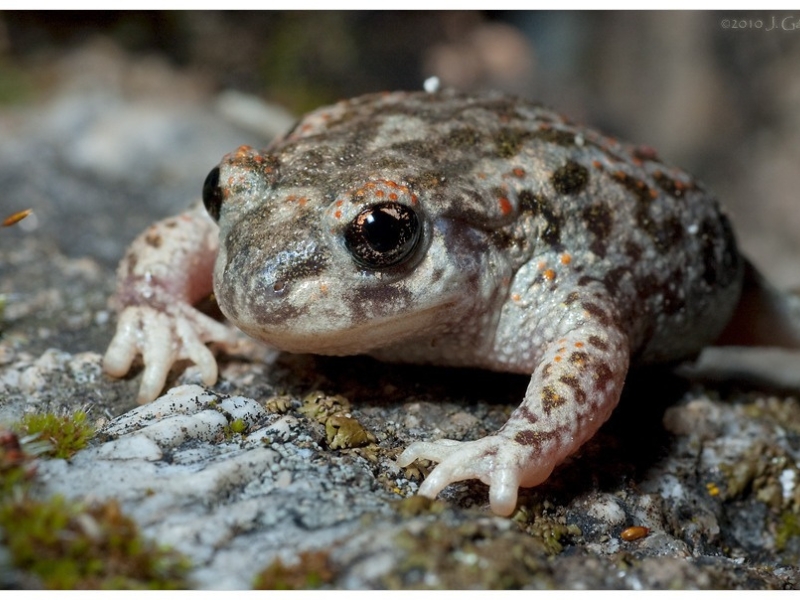
- Israeli Fat Sand Rat (Psammomys obesus): The Israeli Fat Sand Rat is a species of rodent found in deserts across the Middle East, including the Negev Desert. Adapted to a life in arid conditions, it feeds on saltbush and other halophytic plants, which are abundant in its habitat. The Fat Sand Rat’s diet and behavior are closely linked to its desert environment, demonstrating how organisms adapt to extract moisture and nutrients from seemingly inhospitable landscapes.
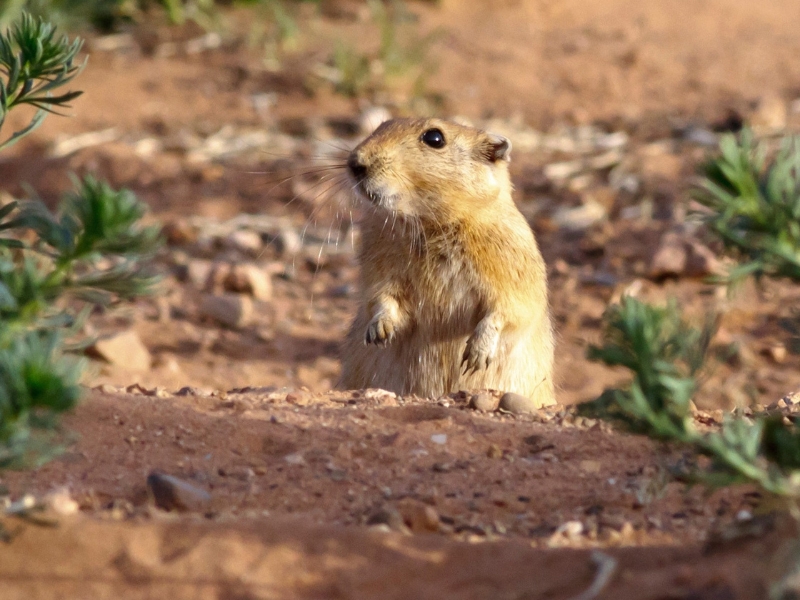
What are Dangerous Animals that Start With I?
Here are the top 5 Dangerous Animals that Start With I:
- Indian Cobra (Naja naja): Indian Cobras are highly venomous snakes found throughout the Indian subcontinent. They are responsible for numerous snakebite incidents, posing a significant threat to human health and safety. Indian Cobras are known for their hooded appearance and potent neurotoxic venom, which can cause paralysis and respiratory failure if not promptly treated with antivenom.
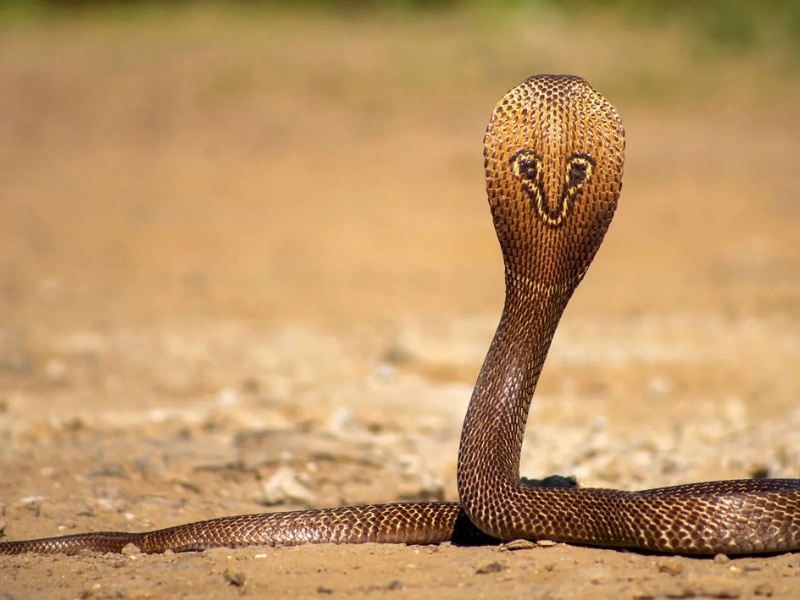
- Indonesian Komodo Dragon (Varanus komodoensis): The Komodo Dragon, found on the Indonesian islands of Komodo, Rinca, Flores, and Gili Motang, is the largest living species of lizard. It has a venomous bite that can be deadly due to the combination of venom and bacteria in its saliva, which can cause sepsis and rapid blood loss in its prey.
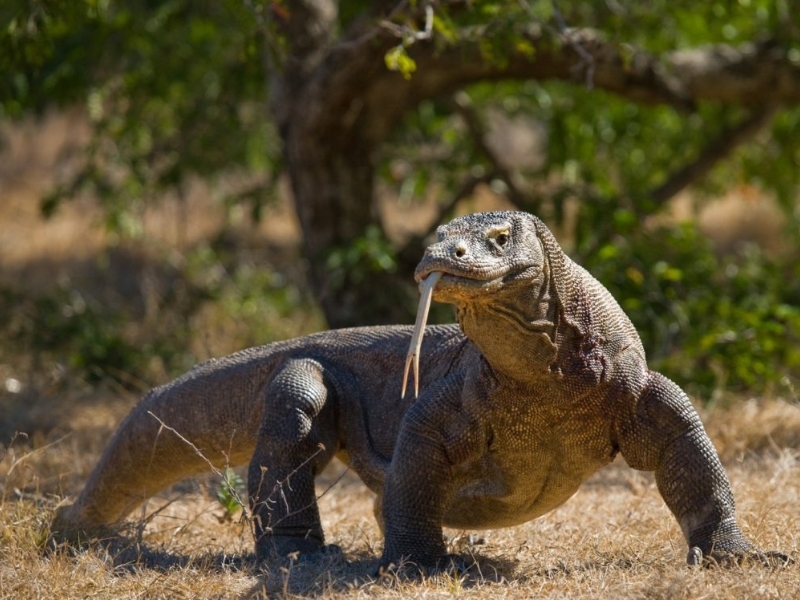
- Indian Flying Fox (Pteropus giganteus): Indian Flying Foxes can carry diseases such as rabies and Hendra virus, posing a risk to public health if individuals come into contact with their saliva or bodily fluids. These large fruit bats are known to roost in urban areas, increasing the potential for human-wildlife conflicts and disease transmission.
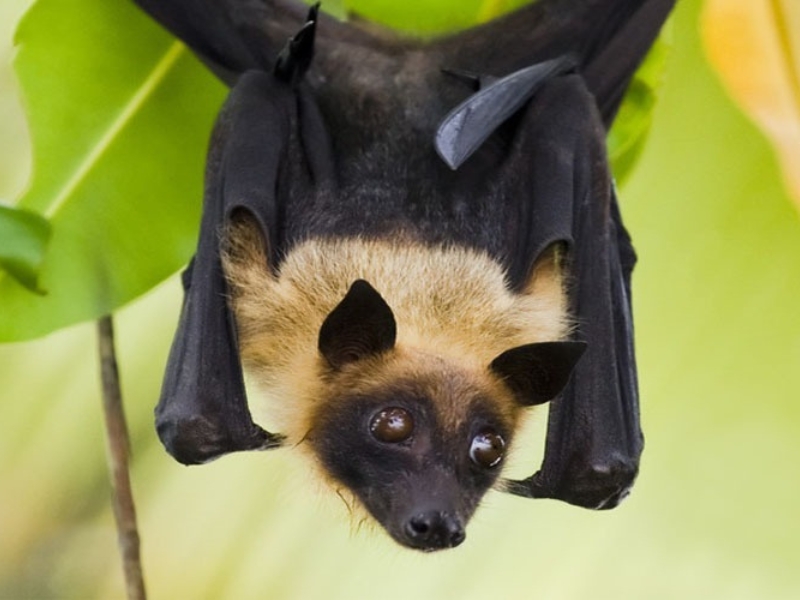
- Invasive Red Fire Ant (Solenopsis invicta): Originally from South America, the Invasive Red Fire Ant has spread to various parts of the world, including the United States and Australia, where it is considered a dangerous invasive species. Its sting is painful and can cause allergic reactions in sensitive individuals.
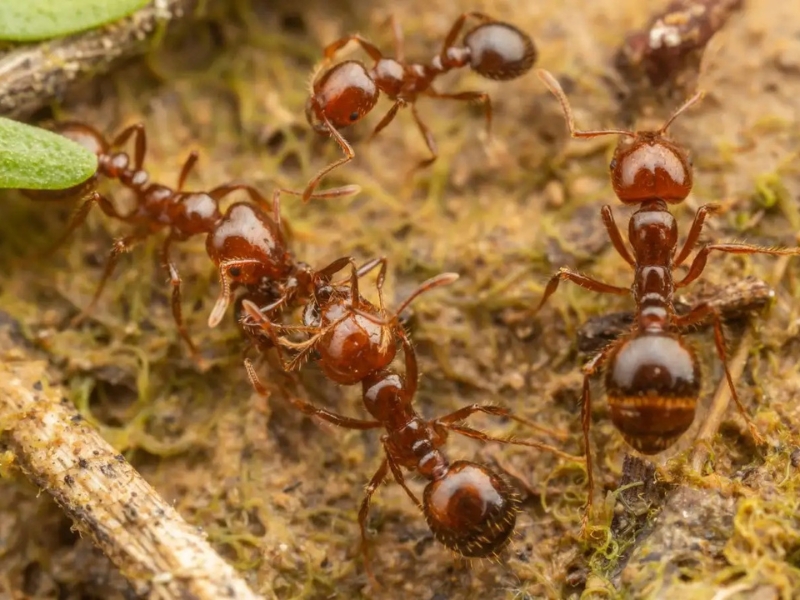
Irwin’s Sea Snake (Aipysurus irwini): Named in honor of the famous naturalist Steve Irwin, Irwin’s Sea Snake is found in the coastal waters of Australia. This sea snake possesses potent venom that it uses to immobilize its fish prey. Irwin’s Sea Snake can be dangerous if threatened or mishandled, underscoring the importance of respecting wildlife and maintaining a safe distance from potentially venomous animals.
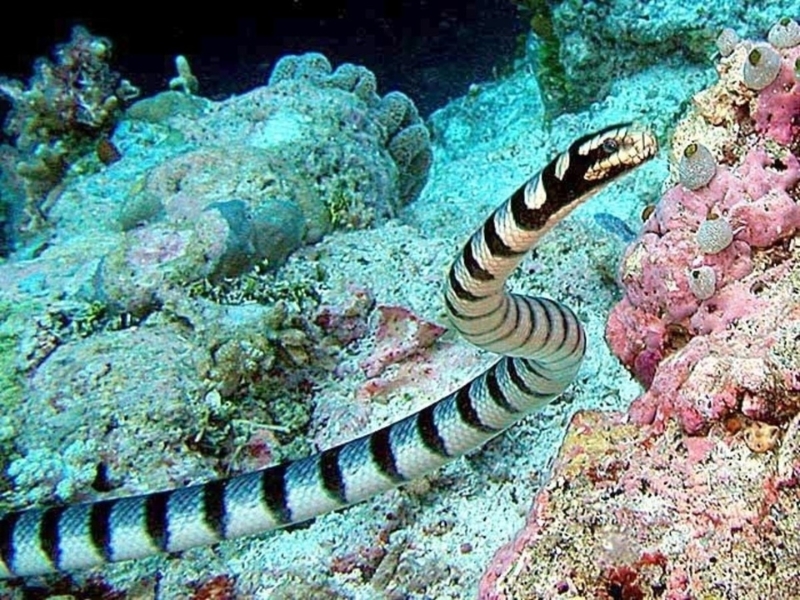
This article highlights the incredible variety and uniqueness of the natural world. From the industrious Indian Star Tortoise to the intriguing Indian Cobra, these creatures captivate us with their fascinating behaviors, adaptations, and habitats. Each animal serves as a reminder of the delicate balance and interdependence of life on our planet. By learning about these remarkable species, we gain not only knowledge but also a greater appreciation for the diversity of Earth’s ecosystems.
If you’re searching for animal names starting with a different letter, explore our other comprehensive articles dedicated to animal names.

